 |
Collier County |
 |
Land Development Code |
 |
Chapter 4. SITE DESIGN AND DEVELOPMENT STANDARDS |
 |
Appendix 4.02.00. SITE DESIGN STANDARDS |
§ 4.02.16. Design Standards for Development in the Bayshore Gateway Triangle Redevelopment Area
A.
Dimensional and Design Standards for the BMUD.
1.
Neighborhood Commercial Subdistrict (BMUD-NC).
a.
Specific District Provisions:
i.
Maximum Density : 12 units per acre comprised of density allowed by the underlying zoning district and available density bonuses.
ii.
Lot and building dimensional requirements for new development are provided below. These requirements shall be based on the building type of the principal structure(s) as described in section 4.02.16 D., Building Types and Architectural Standards.
Table 1. Dimensional Requirements in the BMUD-NC
House Rowhouse Apartment Mixed-Use Commercial Civic & Institutional Min. Lot Width (ft) 50 25 100 100 100 100 Min. Front Yard (ft) 10 10 10 5 5 10 Max. Front Yard (ft) 20 15 20 20 20 20 Min. Side Yard (ft) 5 5 5 5 5 10 Min. Rear Yard (ft) 15 15 20 20 20 20 Waterfront Yard (ft) 25 25 25 25 25 25 Min. Floor Area (sq ft) 700 700 700 per unit 700 per unit 700 per unit n/a Min. Building Separation n/a n/a 10 10 10 10 Max. Building Height (ft) 42 42 42 56 56 42 Notes:
See 4.02.16.A.7 regarding Duplexes .
See 4.02.16.A.7 regarding Two-Family Dwellings .
Applies to individual unit.
Zoned Height of Building .
Property zoned C-3 shall have a minimum lot width of 75 feet.
2.
Waterfront Subdistrict (BMUD-W).
a.
Specific District Provisions:
i.
Maximum Density : 12 units per acre comprised of density allowed by the underlying zoning district and available density bonuses.
ii.
Lot and building dimensional requirements for new development are provided below. These requirements shall be based on the building type of the principal structure(s) as described in section 4.02.16 D., Building Types and Architectural Standards.
Table 2. Dimensional Requirements in the BMUD-W
House Rowhouse Apartment Mixed-Use Commercial Civic & Institutional Min. Lot Width (ft) 50 25 100 100 100 100 Min. Front Yard (ft) 10 10 10 5 5 10 Max. Front Yard (ft) 20 15 20 20 20 20 Min. Side Yard (ft) 5 5 5 5 5 10 Min. Rear Yard (ft) 15 15 20 20 20 20 Waterfront Yard (ft) 25 25 25 25 25 25 Min. Floor Area (sq ft) 700 700 700 per unit 700 per unit 700 per unit n/a Min. Building Separation n/a n/a 10 10 10 10 Max. Building Height (ft) 42 42 42 56 56 42 Notes:
See 4.02.16.A.7 regarding Duplexes .
See 4.02.16.A.7 regarding Two-Family Dwellings .
Applies to individual unit.
Zoned Height of Building .
Property zoned C-3 shall have a minimum lot width of 75 feet.
3.
Residential 1 Subdistrict (BMUD-R1).
a.
Specific District Provisions:
i.
Maximum Density is limited to the maximum density allowed by the underlying zoning district and any available density bonuses.
ii.
Lot and building dimensional requirements for new development are provided below. These requirements shall be based on the building type of the principal structure(s) as described in section 4.02.16 D., Building Types and Architectural Standards.
Table 3. Dimensional Requirements in the BMUD-R1
House Rowhouse Apartment Civic & Institutional Min. Lot Width (ft) 50 25 100 100 Min. Front Yard (ft) 10 10 10 10 Min. Side Yard (ft) 7.5 5 7.5 10 Min. Rear Yard (ft) 15 15 15 15 Min. Floor Area (sq ft) 1,100 1,000 750 per unit n/a Min. Building Separation n/a n/a 10 10 Max. Building Height (ft) 35 35 35 35 Notes:
See 4.02.16.A.7 regarding Duplexes .
See 4.02.16.A.7 regarding Two-Family Dwellings .
Applies to individual unit.
Zoned Height of Building .
4.
Residential 2 Subdistrict (BMUD-R2).
a.
Specific District Provisions:
i.
Maximum Density is limited to the maximum density allowed by the underlying zoning district and any available density bonuses.
ii.
Lot and building dimensional requirements for new development are provided below. These requirements shall be based on the building type of the principal structure(s) as described in section 4.02.16 D., Building Types and Architectural Standards.
Table 4. Dimensional Requirements in the BMUD-R2
House Rowhouse Apartment Civic & Institutional Min. Lot Width (ft) 50 25 100 100 Min. Front Yard (ft) 25 25 25 25 Min. Side Yard (ft) 7.5 5 7.5 10 Min. Rear Yard (ft) 15 15 15 15 Min. Floor Area (sq ft) 1,100 1,000 750 per unit n/a Min. Building Separation n/a n/a 10 10 Max. Building Height (ft) 35 35 35 35 Notes:
See 4.02.16.A.7 regarding Duplexes .
See 4.02.16.A.7 regarding Two-Family Dwellings .
Applies to individual unit.
Zoned Height of Building .
5.
Residential 3 Subdistrict (BMUD-R3).
a.
Specific District Provisions:
i.
Maximum Density is limited to the maximum density allowed by the underlying zoning district and any available density bonuses.
ii.
Lot and building dimensional requirements for new development are provided below. These requirements shall be based on the building type of the principal structure(s) as described in section 4.02.16 D., Building Types and Architectural Standards.
Table 5. Dimensional Requirements in the BMUD-R3
House Mobile Home Rowhouse Apartment Civic & Institutional Min. Lot Width (ft) 40 40 25 100 100 Min. Front Yard (ft) 10 25 10 10 10 Min. Side Yard (ft) 5 7.5 5 7.5 10 Min. Rear Yard (ft) 8 10 8 15 15 Min. Floor Area (sq ft) 1,100 n/a 1,000 750 per unit n/a Min. Building Separation n/a n/a n/a 10 10 Max. Building Height (ft) 35 30 35 35 35 Notes:
See 4.02.16.A.7 regarding Duplexes .
See 4.02.16.A.7 regarding Two-Family Dwellings .
Applies to individual unit.
Zoned Height of Building .
6.
Residential 4 Subdistrict (BMUD-R4).
a.
Specific District Provisions:
i.
Maximum Density is limited to the maximum density allowed by the underlying zoning district and any available density bonuses.
ii.
Lot and building dimensional requirements for new development are provided below. These requirements shall be based on the building type of the principal structure(s) as described in section 4.02.16 D., Building Types and Architectural Standards.
Table 6. Dimensional Requirements in the BMUD-R4
House Civic & Institutional Min. Lot Width (ft) 50 100 Min. Front Yard (ft) 25 10 Min. Side Yard (ft) 7.5 10 Min. Rear Yard (ft) 15 15 Min. Floor Area (sq ft) 1,100 n/a Min. Building Separation n/a 10 Max. Building Height (ft) 35 35 Notes:
See 4.02.16.A.7 regarding Duplexes .
Zoned Height of Building .
7.
Exceptions to Dimensional Requirements:
a.
For infill lots , the minimum front and side setbacks shall be equal to the average setback dimensions on lots within 500 feet on the same block.
b.
A zero side setback is allowed for Rowhouse , Apartment, Mixed Use and Commercial building types, where permitted, if a party wall is provided.
c.
Duplexes , where permitted, are subject to dimensional standards for a house building type, but shall have a minimum of 1,000 square feet of building area per unit and a minimum lot width of 50 feet.
d.
Two Family dwelling units, where permitted, are subject to dimensional standards for a rowhouse building type, but shall have a minimum of 1,000 square feet of building area per unit and a minimum lot width of 40 feet per unit.
e.
Setback Encroachments:
i.
Front porches in the BMUD - R1 and BMUD - R3 subdistricts that comply with the design criteria of 4.02.16 D.4.d. are permitted to encroach into the front setback up to 7 feet, with an additional 3 feet encroachment for entry stairs.
ii.
Arcades, awnings , and stairs are permitted to encroach into the front setback up to 5 feet.
iii.
Bay windows may project up to 2 feet into any required setback .
iv.
Uncovered porches and stoops that do not exceed an average finished height above grade of 36 inches may project into any required setback up to 5 feet from the property line.
v.
Handicap ramps installed on a residential structure to provide access for a disabled resident may encroach into the front setback , unless it can be provided at another entry point.
vi.
Accessory structures may encroach into the setbacks as provided in section 4.02.16 C.2.
vii.
Non-structural accessory uses , such as HVAC, mechanical equipment, rain barrels, cisterns and solar panels, may encroach into the side and rear setback .
f.
Height limitations shall not apply to church spires, belfries, cupolas, and domes not intended for human occupancy, monuments, transmission towers, chimneys, smokestacks, flagpoles, masts and antennas . Parapets on a flat roof shall be no more than 5 feet in height at its highest point.
B.
Dimensional and Design Standards for the GTMUD.
1.
Mixed Use Subdistrict (GTMUD-MXD).
a.
Specific District Provisions:
i.
Maximum Density : 12 units per acre comprised of density allowed by the underlying zoning district and available density bonuses.
ii.
Lot and Building Dimensional Requirements: Lot and building dimensional requirements for new development are provided below. These requirements shall be based on the building type of the principal structure(s) as described in section 4.02.16 D., Building Types and Architectural Standards.
Table 7. Dimensional Requirements in the GTMUD-MXD
House Rowhouse Apartment Mixed-Use Commercial Civic & Institutional Min. Lot Width (ft) 50 25 100 100 100 100 Min. Front Yard (ft) 10 10 10 6.5 6.5 10 Min. Side Yard (ft) 7.5 5 7.5 10 10 10 Min. Rear Yard (ft) 15 15 20 5 5 15 Min. Waterfront Setback (ft) 25 25 25 25 25 25 Min. Floor Area (sq ft) 1,100 1,000 750 per unit 700 per unit 700 per unit n/a Min. Building Separation n/a n/a 10 10 10 10 Max. Building Height (ft) 42 42 42 56 56 42 Notes:
See 4.02.16.B.3 regarding Duplexes .
See 4.02.16.B.3 regarding Two-Family Dwellings .
Applies to individual unit.
Zoned Height of Building .
Property zoned C-3 shall have a minimum lot width of 75 feet.
Development in the Mini-Triangle Area of the GTMUD-MXD subdistrict shall have a maximum setback of 20 feet.
MUPs in the Mini-Triangle Area of the GTMUD-MXD subdistrict shall have a maximum zoned building height of 112 feet.
2.
Residential Subdistrict (GTMUD R).
a.
Specific District Provisions:
i.
Maximum Density is based on maximum density allowed by the underlying zoning district and any available density bonuses.
ii.
Lot and Building Dimensional Requirements: Lot and building dimensional requirements for new development are provided below. These requirements shall be based on the building type of the principal structure(s) as described in section 4.02.16 D, Building Types and Architectural Standards.
Table 8. Dimensional Requirements in the GTMUD R
House Rowhouse Apartment Civic & Institutional Min. Lot Width (ft) 50 25 100 100 Min. Lot Size (sq ft) n/a n/a 10,000 10,000 Min. Front Yard (ft) 10 10 10 10 Min. Side Yard (ft) 7.5 5 7.5 10 Min. Rear Yard (ft) 15 15 15 15 Min. Floor Area (sq ft) 1,100 1,000 750 per unit n/a Min. Building Separation n/a n/a 10 10 Max. Building Height (ft) 35 35 35 35 Notes:
See 4.02.16.A.7 regarding Duplexes .
See 4.02.16.A.7 regarding Two-Family Dwellings .
Applies to individual unit.
Zoned Height of Building .
3.
Exceptions to Dimensional Requirements:
a.
For infill lots , the minimum front and side setbacks shall be equal to the average setback dimensions on lots within 500 feet.
b.
A zero side setback is allowed for Rowhouse, Apartment, Mixed Use and Commercial building types, where permitted, if a shared wall, or party wall, is provided.
c.
Duplexes , where permitted, are subject to dimensional standards for a house building type, but shall have a minimum of 1,000 square feet of building area per unit and a minimum lot width of 80 feet.
d.
Two Family units, where permitted, are subject to dimensional standards for a rowhouse building type, but shall have a minimum of 1,000 square feet of building area per unit and a minimum lot width of 40 feet per unit.
e.
Setback Encroachments:
i.
Front porches in the GTMUD - R subdistrict that comply with the design criteria of section 4.02.16 D.4.d. are permitted to encroach into the front setback up to 7 feet, with an additional 3 feet encroachment for entry stairs.
ii.
Arcades, awnings , stairs and raised doorways are permitted to encroach into the front setback up to 5 feet.
iii.
Bay windows may project up to 2 feet into any required setback .
iv.
Uncovered porches and stoops that do not exceed an average finished height above grade of 36 inches may project into any required setback up to 5 feet from the property line.
v.
Handicap ramps installed on a residential structure to provide access for a disabled resident may encroach into the front setback , unless it can be provided at another entry point.
vi.
Accessory structures may encroach into the setbacks as provided in section 4.02.16 C.2
vii.
Non-structural accessory uses , such as HVAC, mechanical equipment, rain barrels, cisterns and solar panels, may encroach into the side and rear setback .
f.
Height limitations shall not apply to church spires, belfries, cupolas, and domes not intended for human occupancy, monuments, transmission towers, chimneys, smokestacks, flagpoles, masts and antennas . Parapets on a flat roof can be no more than 5 feet in height.
C.
Additional Standards for Specific Uses. Certain uses may be established, constructed, continued, and/or expanded provided they meet certain mitigating standards specific to their design and/or operation. These conditions ensure compatibility between land uses and building types and minimize adverse impacts to surrounding properties.
1.
Accessory Parking Zones.
a.
Lots adjacent to the Neighborhood Commercial (BMUD-NC), Waterfront (BMUD-W) and Mixed Use (GTMUD-MXD) Subdistricts, designated Accessory Parking Zoning (APZ) as identified on the Collier County Zoning Map, may be used for off street parking or water retention and management areas, in the following manner:
i.
As an accessory use to an adjacent non-residential principal use under the same ownership or legal control; or
ii.
As a public parking lot designated as a principal use .
b.
A buffer must be provided between the APZ and adjacent residential lots as provided in section 4.02.16 E.2.a.i.
2.
Accessory Uses to Residential Structures . An accessory structure located on the property and related to the primary residence (single-family detached only) for uses which include, but are not limited to: library, studio, workshop, playroom, screen enclosure, detached garage, swimming pool or guesthouse .
a.
Ownership of an accessory structure shall not be transferred independently of the primary residence.
b.
Accessory building(s) , excluding swimming pools and screen enclosures, may be located on up to 30 percent of the side or rear yards . For the purposes of this provision, the yard shall be the area between the principal structure and the side or rear property line.
c.
The maximum area of a guesthouse is 750 square feet, limited to 1 habitable floor; the minimum area is 500 square feet.
d.
The guesthouse must be of new construction and must meet National Flood Insurance Program (NFIP) first habitable floor elevation requirements. The guesthouse may be above a garage or may be connected to the primary residence by an enclosed breezeway or corridor not to exceed 8 feet in width.
e.
Fences and walls: Fences and walls located in the front yard are permitted subject to the following conditions:
i.
The fence or wall shall not exceed 42 inches in height.
ii.
Fence material shall be wood picket, wrought iron or material of similar appearance and durability. Garden or decorative walls may be brick, stone stucco block.
f.
Height: The maximum zoned height of an accessory structure is 26 feet. Screen enclosures may exceed the maximum height, but in no case be higher than the principal structure or 35 feet, whichever is less.
g.
Location: Accessory structures shall not be located in the front yard , except that accessory structures located on corner lots may be located in the front yard with the longer street frontage . Accessory structures shall be setback a minimum of 10 feet from the rear property line and shall have the same side setback as required for the principal structure for the overlay subdistrict in which it is located.
3.
Artist Village.
a.
Artist village is limited to the housing of artists, such as painters, sculptors, jewelry makers, in one or more multifamily attached dwellings , clustered single-family detached dwellings , or a combination thereof.
b.
Dwellings shall not be leased for periods less than 30 days.
c.
Artist village consisting of clustered, single-family detached dwellings , shall be designed consistent with the provisions for cluster residential design in section 4.02.04.
d.
Shared studio and/or gallery space shall be provided for the use of all residents of the artist village .
4.
Bed and Breakfast Facilities.
a.
Minimum number of guest rooms or suites is 2 with a maximum number of 6. Guest occupancy is limited to a maximum stay of 30 days. The minimum size of bedrooms for guest occupancy shall be 100 square feet.
b.
No cooking facilities shall be allowed in guest rooms.
c.
Separate toilet facilities for the exclusive use of guests must be provided. At least 1 bathroom for each 2 guestrooms shall be provided.
d.
Parking: 2 spaces plus 1 space for each bedroom. All other applicable provisions of this LDC relative to parking facilities shall apply.
e.
Signage: 1 sign with a maximum sign area of 4 square feet containing only the name of the proprietor or name of the residence. Signs shall not be illuminated in residential subdistricts.
f.
A 24 hour on-site manager is required.
5.
Community Garden .
a.
The property shall be maintained in good condition consistent with the County's property maintenance standards. All planting materials, tools, and equipment must be removed from the site each day or secured in a permitted accessory structure .
b.
Hours of operation shall be limited to dawn to dusk.
c.
The sale of items from the property shall be prohibited, except by an approved special event.
d.
Any use of fertilizer must comply with provisions set forth in Collier County Code of Ordinances, Article II: Florida-Friendly Use of Fertilizers on Urban Landscapes.
e.
Required Yards :
i.
Accessory buildings , including storage sheds or greenhouses, are permitted on site and must meet the principal structure setbackrequirements for the subdistrict in which it is located.
ii.
All plantings shall be setback a minimum of 10 feet from the street right-of-way and five feet from the rear and side property lines.
f.
Operating Procedures: A community garden must have a set of operating rules addressing the following:
i.
Identification of, and contact information for, a garden coordinator to perform the coordinating role for the management of the community gardens ;
ii.
Maintenance and security requirements and responsibilities;
iii.
Identification of how garden plots are assigned in a fair and impartial manner.
6.
Live-Work Units .
a.
All live-work units must fully comply with any and all Building Code requirements.
b.
The non-residential use areas shall meet accessibility requirements of the applicable Building Code (including site access and parking) and be oriented to the street .
c.
Size: The live-work unit shall have a minimum total size of 1,000 square feet and a maximum total size of 3,000 square feet and three stories in height. The non-residential use area must occupy less than 50 percent of total unit.
d.
The same individual(s) must occupy the non-residential use area and living area.
e.
The live-work unit may employ a maximum of 1 non-resident worker/employee on premise at any one time.
f.
Live-work units in non-residential subdistricts (BMUD-NC, BMUD-W and GTMUD-MXD) shall be established through the mixed use project approval process .
g.
Limitations on use. The non-residential component of a live-work unit shall be limited in the following manner:
i.
Live-work units in a non-residential subdistrict (BMUD-NC, BMUD-W and GTMUD-MXD) limited to uses permitted within the applicable subdistrict or underlying zoning district.
ii.
Live-work units approved as a conditional use in a residential subdistrict (BMUD-R3 and GTMUD-R) shall be limited to non-residential uses including artist studio, professional office, professional service such as hair salon or tailor, or any other use deemed to be similar in nature by the BZA during the conditional use process. Non-residential uses may include ancillary retail, such as galleries selling artwork and hair salons selling hair products.
iii.
Prohibited uses include Vehicle Maintenance or Repair, Entertainment, Drinking and Public Eating Establishment, the sale of food and beverages, Sexually-Oriented Businesses, veterinary services, and activities involving biological or chemical substances that require a controlled environment or may pose a health hazard.
h.
Parking: 1 parking space per 500 square feet of the non-residential portion of the live-work unit plus 1 space for the residential unit.
i.
Signage: Signage for live-work units in a commercial subdistrict shall be limited to wall signs in accordance with section 5.06.04. Live-work units located in a residential subdistrict shall be limited to 1 non-illuminated wall sign with a maximum sign area of 8 square feet.
7.
Marinas and Boatyards .
a.
Repair and dry storage areas shall not be visible from the street .
b.
Boats available for rental purposes shall be located in the water or screened with a fence or wall from the local side streets and adjacent residential lots and shall not be visible from Bayshore Drive.
c.
All boat racks shall be enclosed with a wall or fence and the boats shall not exceed the height of the enclosure. The fence material can be wood, vinyl composite, concrete block with stucco finish or metal or a combination. No chain link fence is allowed.
d.
Height of structures may be increased to a maximum actual height of 50 feet by the Board of Zoning Appeals (BZA) upon approval of a variance petition.
e.
Outdoor displays of boats for sale on properties fronting Bayshore Drive shall be limited to the following:
i.
All areas used for boat display activities shall occupy no more than 35 percent of the linear frontage of the property.
ii.
All boat sale areas shall not be closer to the frontage line than the primary building they serve.
iii.
All boats located within an outdoor sales area shall not exceed the height of 17 feet above existing grade .
iv.
Outdoor sales areas shall be connected to the parking area and primary structure by a pedestrian walkway.
v.
An additional 10 foot landscape buffer is required around the perimeter of the outdoor boat sales area. This buffer must include, at a minimum 14 foot high trees, spaced at 30 feet on center and a 3 foot high double row hedge spaced at three feet on center at the time of planting.
f.
One parking space per 5 dry boat storage spaces.
g.
On-site traffic circulation system shall be provided that will accommodate areas for the loading and unloading of equipment that will not encroach upon residential developments .
8.
Mixed Use Project.
a.
Mixed Use Projects are typically human-scale, pedestrian-oriented, interconnected projects with a mix of residential and commercial uses such as retail, office and civic amenities that complement each other. Residential uses are often located above commercial uses, but can be separate areas of residential use only with close proximity to commercial uses. An interconnected street system is the basis for the transportation network. Buildings are encouraged to be built close to the vehicular and pedestrian way to create a continuous active and vibrant streetscape utilizing the architecture, landscaping, lighting, signage, and street furnishings.
b.
Mixed Use Projects in the BMUD-NC, BMUD-W and GTMUD-MXD shall be reviewed and permitted in accordance with section 10.02.15.
c.
A minimum of 60 percent of all commercial uses within a mixed use project shall provide retail, office and/or personal service uses to serve the needs of the subject project and surrounding residential neighborhoods.
d.
A maximum of 25 percent of the residential units within a mixed use project shall be on gated roadways. Residential uses shall be constructed concurrent with, or prior to, the construction of commercial uses so as to insure actual development of a mixed use project, or otherwise in accordance with a development schedule approved for the project and made a condition of the MUP approval .
e.
MUPs shall provide connection to local streets , adjoining neighborhoods and adjacent developments , regardless of land use types. A grid street pattern is preferred; however, modifications may be approved, provided the vehicular network provides interconnections between internal uses and external connections to adjoining neighborhoods and land uses. The network shall fully accommodate pedestrian, bicycle, and transit.
f.
The commercial component of a mixed use project may be located internal to the project or along the boundary; if externally located, internal access roads and service access shall be provided so as not to promote strip commercial development along external collector and arterial roadways .
g.
Parking lots shall be dispersed throughout the project. No one parking lot shall provide more than 40 percent of the required off- street parking. Parking garages shall have no restrictions on percentage of required parking that may be accommodated. This requirement shall not apply to individual parcels less than 5 acres in size.
h.
At least 30 percent of the gross area of mixed use projects shall be devoted to useable open space , as defined in section 4.02.01 B. In the case of any request to deviate from this requirement, a donation of land, cash, or other in-kind contribution may be accepted by the CRA, where it has been demonstrated to sufficiently mitigate for the reduction of required on-site usable open space . This cash or in-kind contribution may be used to enhance the public realm (public art, plaza, fountains, etc). This usable open space requirement shall not apply to individual parcels less than 5 acres in size.
9.
Outdoor Display and Sale of Merchandise.
a.
No automatic food and drinking vending machines are permitted outside of any structure.
b.
Newspaper vending machines will be limited to two machines per project site and shall be permanently affixed (not portable).
c.
Outdoor display and sale of merchandise, within front yards on improved properties, is permitted provided the merchandise is limited to the sale of comparable merchandise sold on the premises.
D.
Building Types and Architectural Standards
1.
Purpose and Intent. The purpose of this section is to supplement the provisions of LDC section 5.05.08 by identifying and providing design standards for the building types allowed within the Bayshore Gateway Triangle Redevelopment Area. The standards are intended to attach the same importance to the overall building design as is placed on the use contained therein, and to ensure that proposed development is consistent with the CRA's goals for building form, character and quality. Buildings within the BMUD and GTMUD are expected to be added as long-term additions to the architectural vibrancy of the community.
2.
Applicability. Each proposed building shall be designed in compliance with the standards of this section for the applicable building type, regardless of the underlying zoning district provisions. The uses permitted within the building are determined by the underlying zoning district or overlay subdistrict in which it is located. All buildings shall meet the design requirements set forth in LDC section 5.05.08 unless otherwise specified in this section.
3.
General Architectural Standards.
a.
Architectural Style: The building design standards of this section do not mandate a particular building style and permit a wide variety of architectural expressions. When a building exhibits a known architectural style (i.e., Florida Cracker, Mediterranean, Colonial, Modern) the details shall be consistent throughout the building and any accessory structures on the same site.
b.
Frontage : The primary entrance for any building must be oriented to the street . Orientation is achieved by the provision of a front façade including an entry door that faces the street or square. This requirement shall not apply to mobile homes or to buildings that are interior to a site that has other buildings that meet this provision.
c.
Compatibility: Proposed buildings should relate to adjacent buildings in similarity of scale, height, architectural style, and/or configuration. Exceptions to this provision include civic and institutional buildings such as churches and schools.
d.
Façade Treatment: Architectural elements such as windows and doors, bulkheads, masonry piers, transoms, cornices, window hoods, awnings , canopies, and other similar details shall be used on all façades facing a public right-of-way .
e.
Exterior building color within the Cultural District. Buildings with a mixed use or non-residential use and within the Cultural District boundary, as identified in the Community Redevelopment Agency Resolution 2008-60 as amended, shall meet the following exterior building color standards:
i.
The use of color materials or finish paint above level 10 saturation (chroma) or below lightness level 3 on the Collier County Architectural Color Charts is limited to no more than 10 percent of a façade or the total roof area.
ii.
Natural and manmade materials which exceed the saturation or lightness level requirements of Collier County Architectural Color Charts, such as marble, granite, stone, slate, brick, block, tile, and galvanized metal are permissible.
f.
Deviations from exterior building color. Applicants within the Bayshore Gateway Triangle Community Redevelopment District boundaries may request a deviation from the exterior building color requirements of LDC section 5.05.08 D. A deviation request shall be subject to the procedures established in LDC section 5.05.08 G. and shall be subject to the following criteria:
i.
The deviation request is consistent with LDC section 5.06.00, regarding sign regulations and standards.
ii.
The deviation request consists of no more than 3 colors.
iii.
The deviation request may not be for a color which is below lightness level 3 on the Collier County Architectural Color Charts.
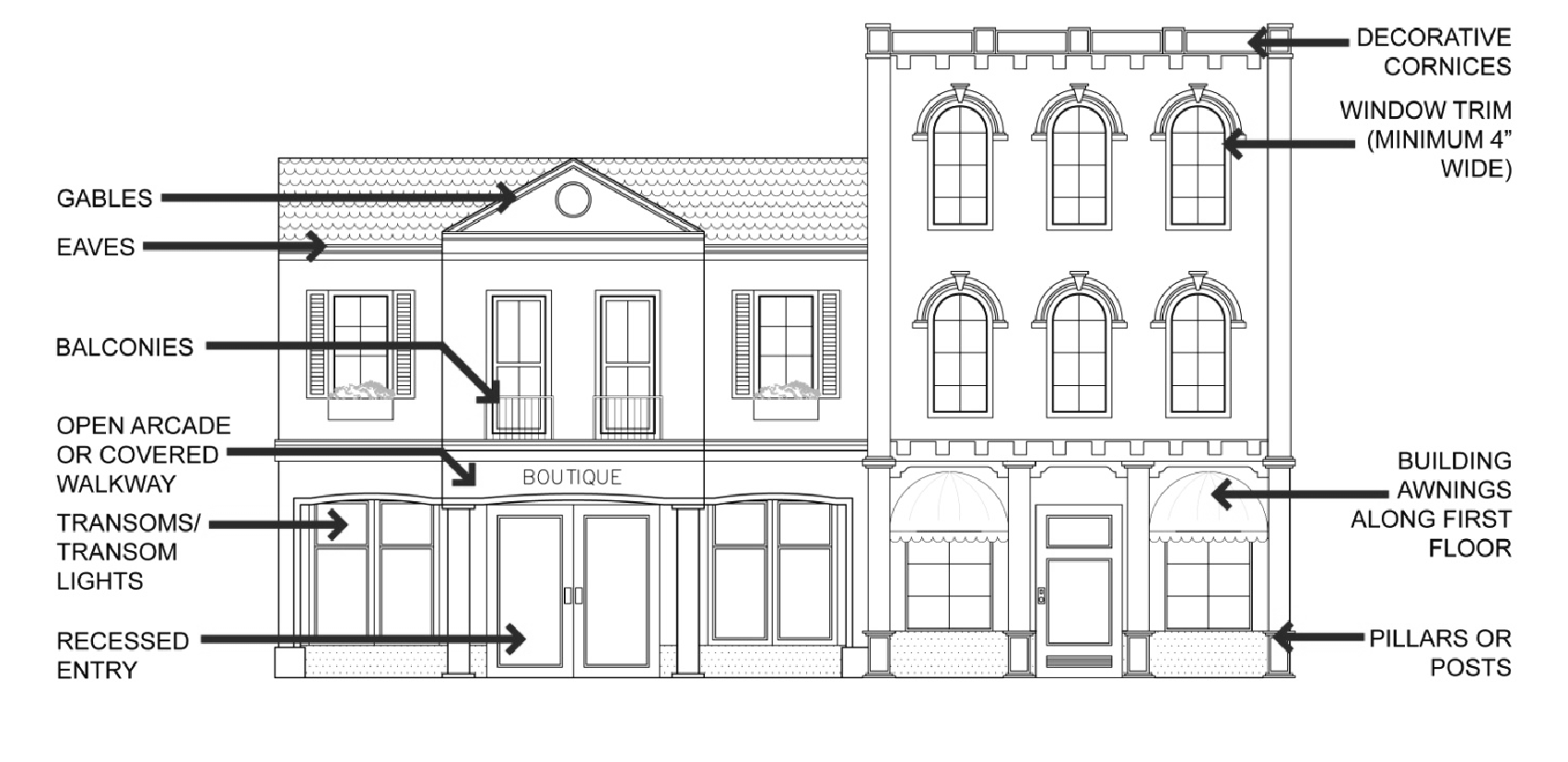
BGT Redevelopment Area Figure 1
Facade Treatments
(For illustrative purposes only)
4.
Building Type: HOUSE.
a.
Description: The predominant building type in the Bayshore Gateway Triangle Redevelopment Area and is intended for use as a single-family detached dwelling located on its own lot , although it may also accommodate duplexes , small multi-family dwellings , home occupations, and professional offices.

BGT Redevelopment Area Figure 2
Building Type: House
(For illustrative purposes only)
b.
Yards : The typical House has four yards : front, sides, and rear. Corner lots shall have two front yards and two side yards , with the front yards along each street frontage .
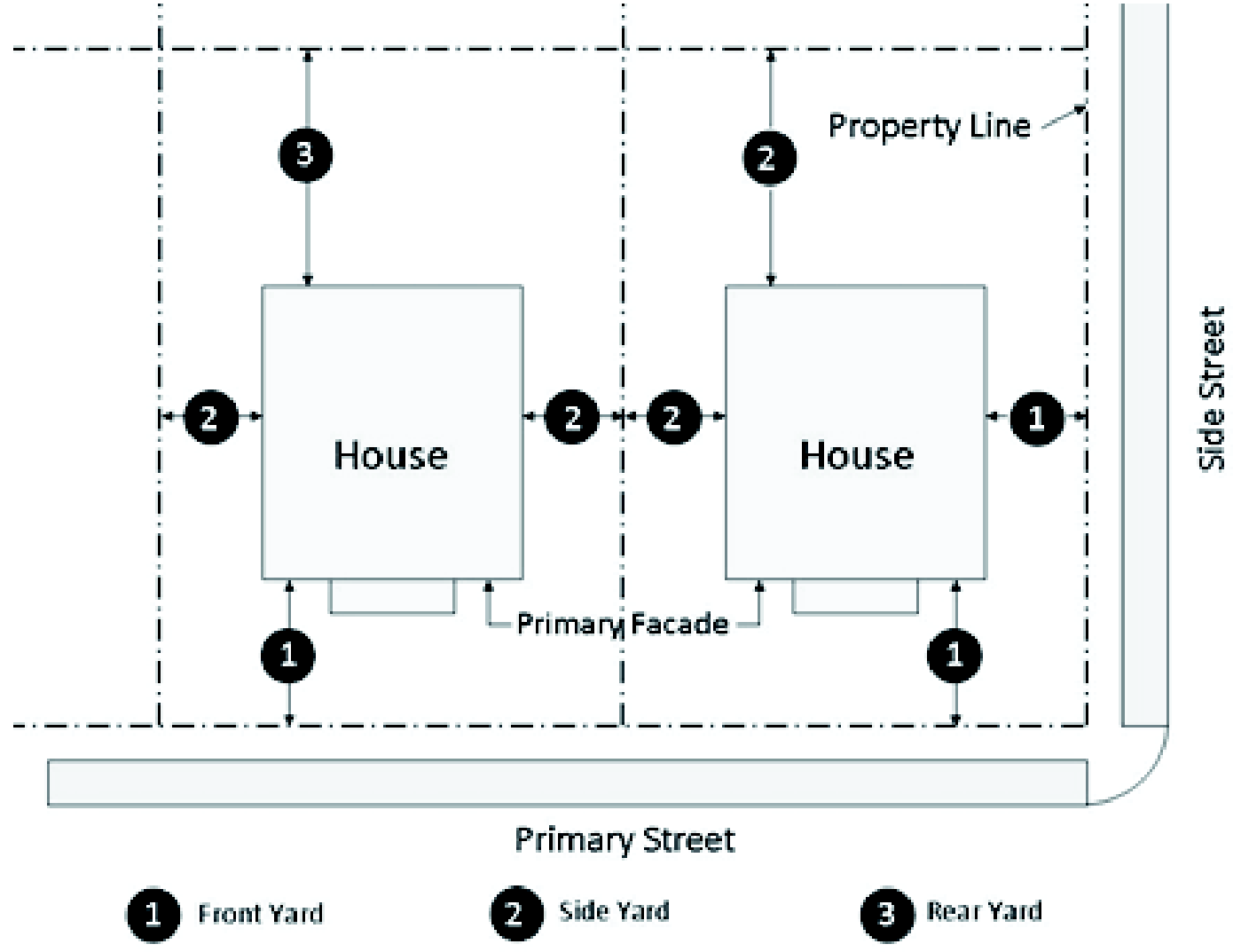
BGT Redevelopment Area Figure 3
House Yard Diagram
(For illustrative purposes only)
c.
Elevation Requirements:
i.
A maximum of two feet of fill shall be allowed on site towards meeting National Flood Insurance Program (NFIP) requirements. Additional NFIP finished habitable floor height requirements shall be accomplished through stem wall construction. Stem walls shall be finished in material and color complimentary to the principal structure .
ii.
Open stilt-type construction is not permitted. On front yards , the foundation area below the first floor must be treated with a solid façade or lattice, which is consistent with the architectural style of the building and the floodplain protection standards of section 3.02.00.
iii.
Parking is permitted under the principal structure . The garage floor shall not exceed 24 inches above the elevation of the crown of road from which it is accessed.
d.
Front Porches:
i.
Front porches should be used as a primary architectural element and may encroach up to 7 feet into the required front setback in accordance with section 4.02.16 A.7.e.i.
ii.
Front porches must cover a minimum of 40 percent of the horizontal length of the front yard façade of the primary residence and be at least 5 feet deep.
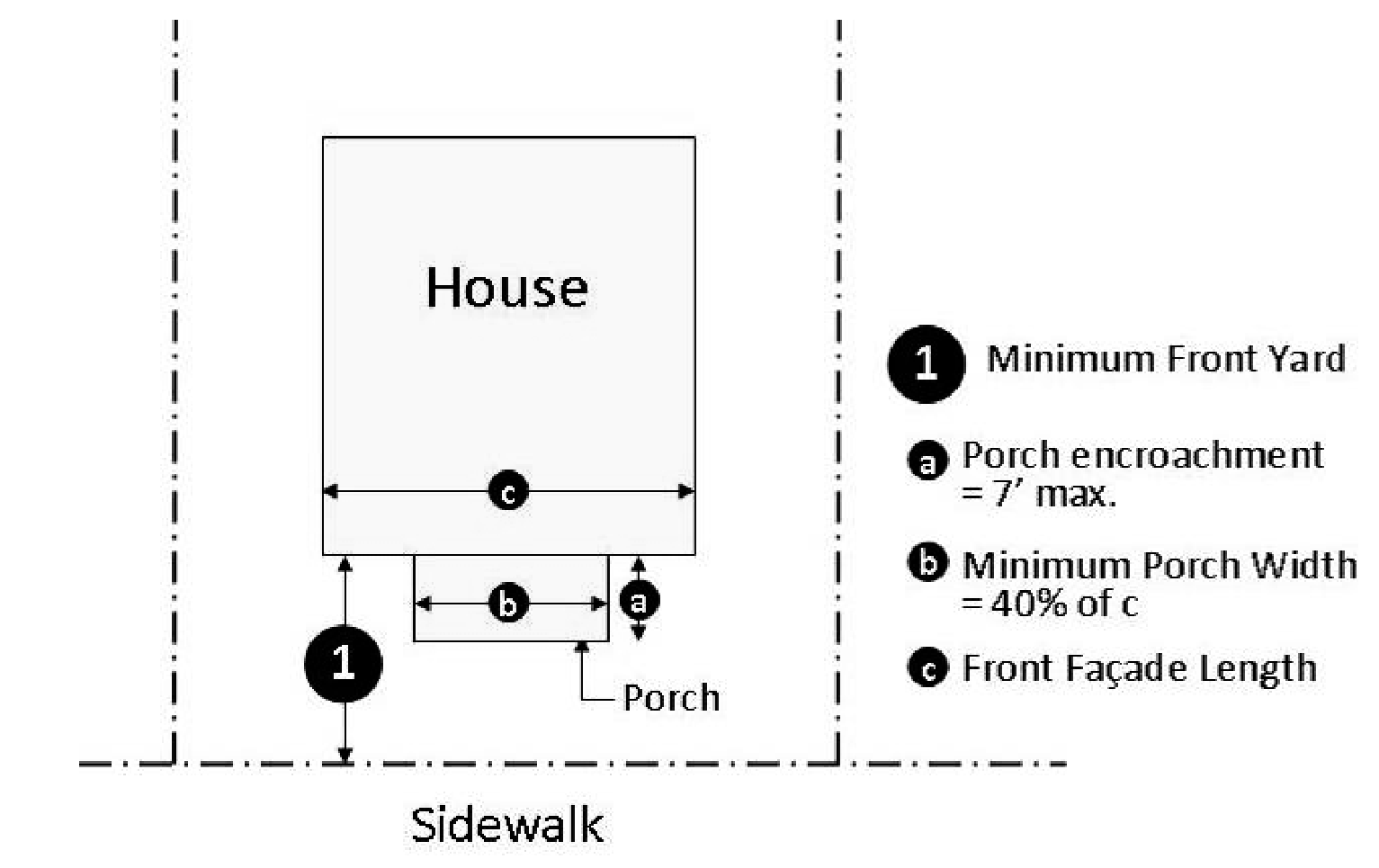
BGT Redevelopment Area Figure 4
House Porch Diagram
(For illustrative purposes only)
iii.
Front porches shall not be air-conditioned or enclosed with glass, plastic, or other materials. Screening the porch is allowed as long as the moldings that hold the screen material matches the material and design character of the structure .
iv.
Front second- story porches are encouraged, but no enclosed room is permitted above the front porch.
e.
Garages, Carports, and Driveways :
i.
Garage doors shall have a maximum width of 16 feet.
ii.
The driveway shall have a maximum width of 18 feet in the right-of-way area. Other than the permitted driveway , the front yard may not be paved or otherwise used to accommodate parking.
iii.
Freestanding carports are prohibited. Carports and porte-cochere must be attached to the principal structure and be of similar materials and design as the principal structure . Detached garages must meet the side and rear setback requirements for an accessory structure . Carports and detached garages shall be no closer than 23 feet from the front yard setback line.
iv.
The distance from the back of the sidewalk to the garage door must be at least 23 feet to allow room to park a vehicle on the driveway without parking over the sidewalk . Should the garage be side-loaded there must be at least a 23 foot paved area on a perpendicular plane to the garage door or plans must ensure that parked vehicles will not interfere with pedestrian traffic.

BGT Redevelopment Area Figure 5
Garages, Carports, and Driveways Diagram
(For illustrative purposes only)
5.
Building Type: ROWHOUSE.
a.
Description: A building with two or more residential units that are attached by a common wall. A rowhouse is typically a fee simple unit from ground to roof with no units above or below. A rowhouse may be used as a live-work unit .
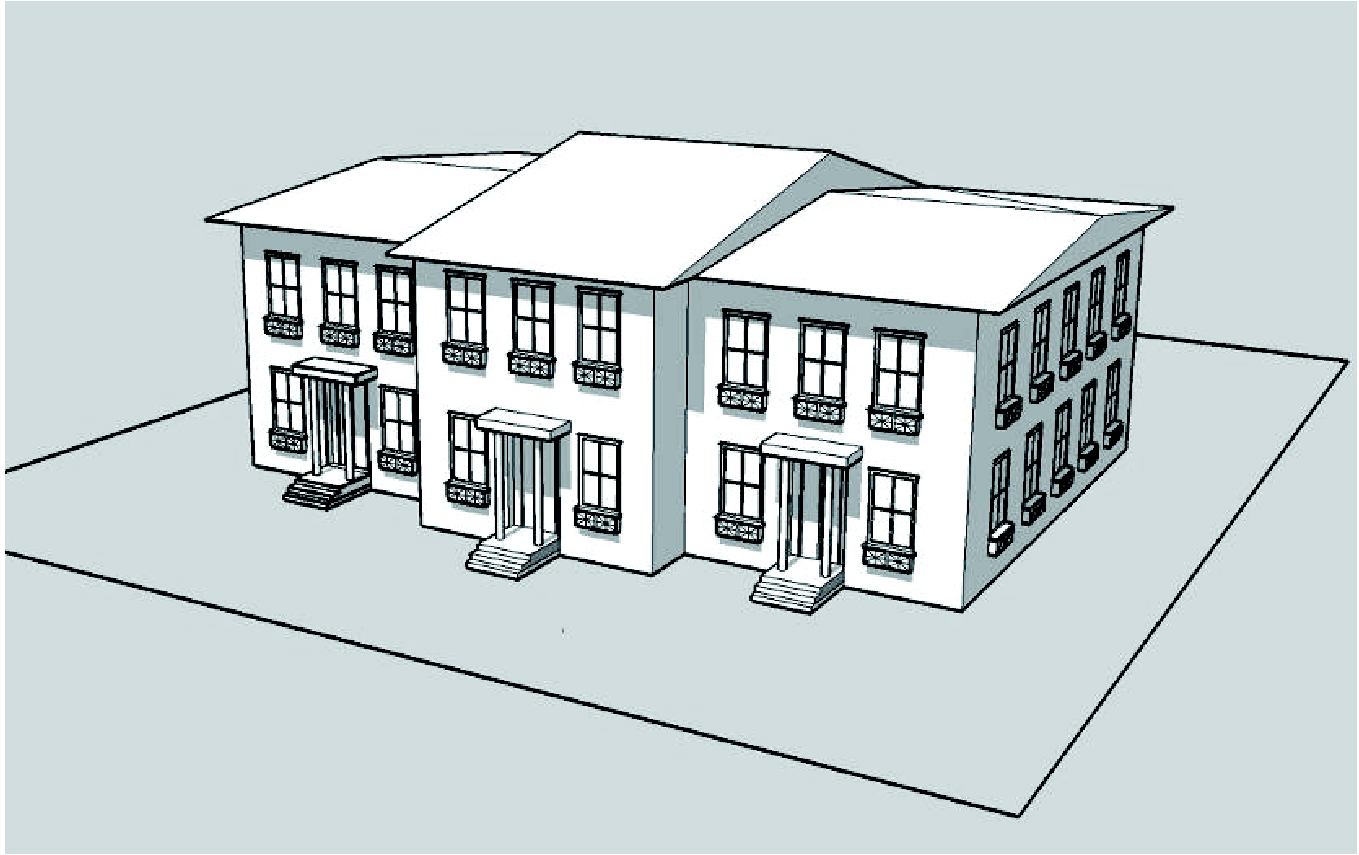
BGT Redevelopment Area Figure 6
Building Type: Rowhouse
(For illustrative purposes only)
b.
Yards : The rowhouse building typically has one primary yard located to the rear of the structure with the potential for a small landscaped front yard . A side yard is required for end units. Corner lots shall have a front yard on each street frontage .

BGT Redevelopment Area Figure 7
Rowhouse Yard Diagram
(For illustrative purposes only)
c.
Front Porches and Stoops:
i.
Front porches should be used as a primary architectural element and may encroach up to 7 feet into the required front setback in accordance with section 4.02.16 A.7.e.i.
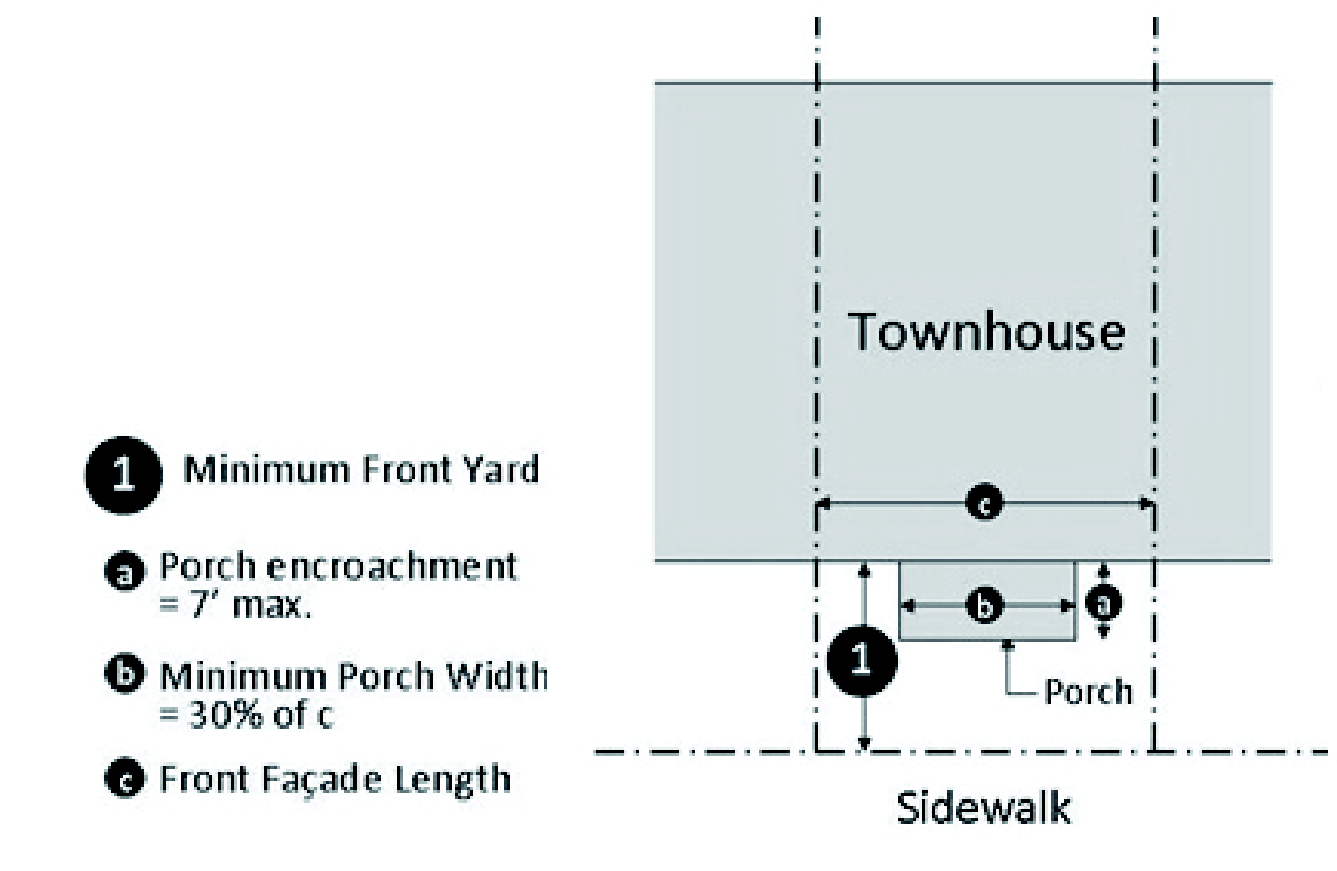
BGT Redevelopment Area Figure 8
Rowhouse Porch Diagram
(For illustrative purposes only)
d.
Elevation Details:
i.
All building elevations visible from the street shall provide doors, porches, balconies, terraces and/or windows along a minimum of 60 percent of the front elevation and 30 percent of the side elevation for each building story . "Percent of elevation" is measured as the horizontal plane containing doors, porches, balconies, terraces and/or windows in relation to the total horizontal plane of the building elevation.
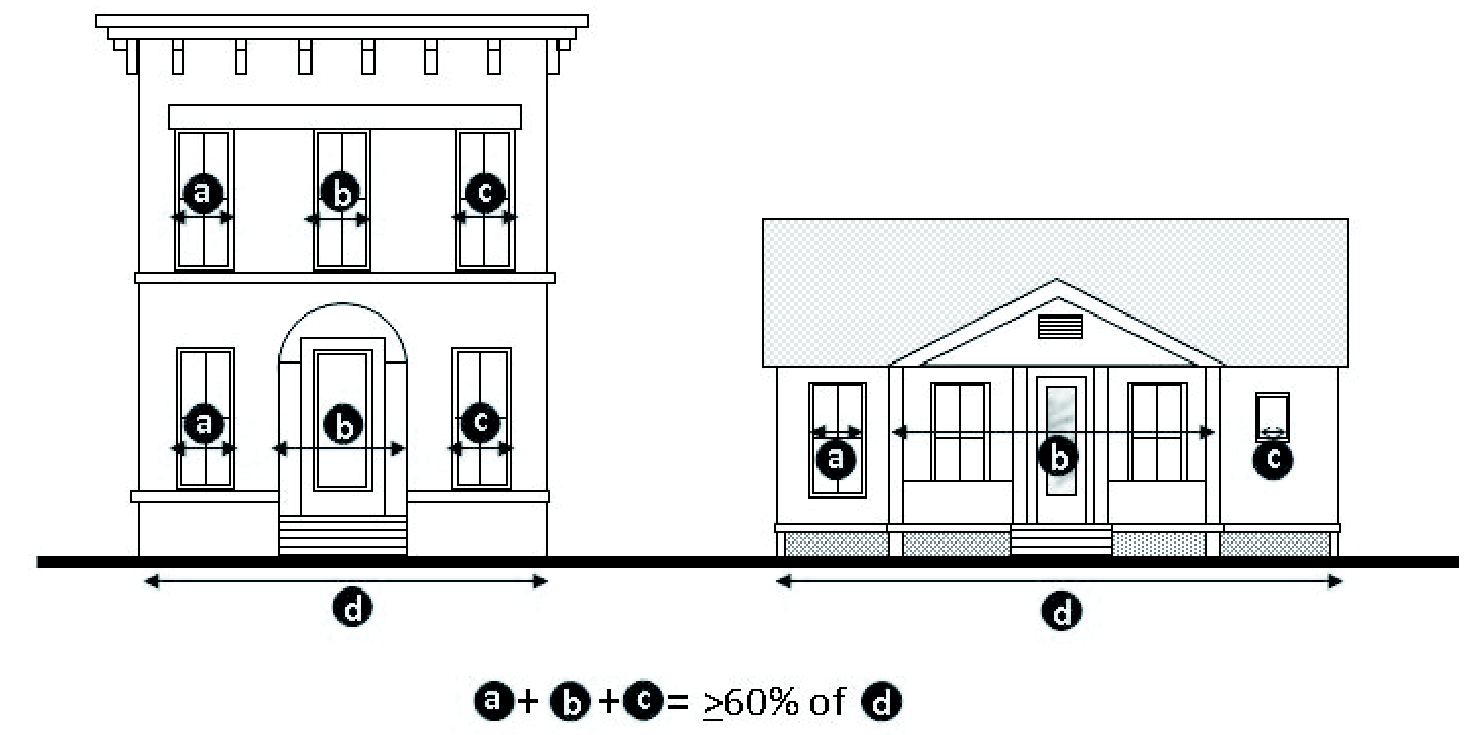
BGT Redevelopment Area Figure 9
Building Elevation Diagram
(For illustrative purposes only)
ii.
All rowhouse buildings are encouraged to provide design details and architectural features to provide visual interest. The types of features may vary on adjacent rowhouse façade that share a common wall, and may include:
a)
Dormers.
b)
Gables.
c)
Recessed entries.
d)
Covered porch entries.
e)
Pillars or posts.
f)
Eaves.
g)
Bay windows.
h)
Balconies.
i)
Decorative finish, such as wainscoating.
j)
Decorative cornices and rooflines (for flat roofs).
k)
Window trim (minimum 4 inches wide).
e.
Garages and Driveways :
i.
Garages and off- street parking spaces are encouraged to be located to the rear of the building .
ii.
Garage provided along the front façade of the building shall meet the following design standards:
a)
Garages shall be recessed from the front façade of the building by a minimum of 5 feet. Driveways shall be designed to provide sufficient room for a parked vehicle without interfering with sidewalks .
b)
Garage doors shall not exceed more than 30 percent of the front elevation.
6.
Building Type: APARTMENT.
a.
Description: A multiple-unit building with units arranged vertically and/or horizontally and with parking located below or behind the building . Units may be for rental or for sale in condominium ownership or may be designed as continuing care facilities or lodging ( hotel ).
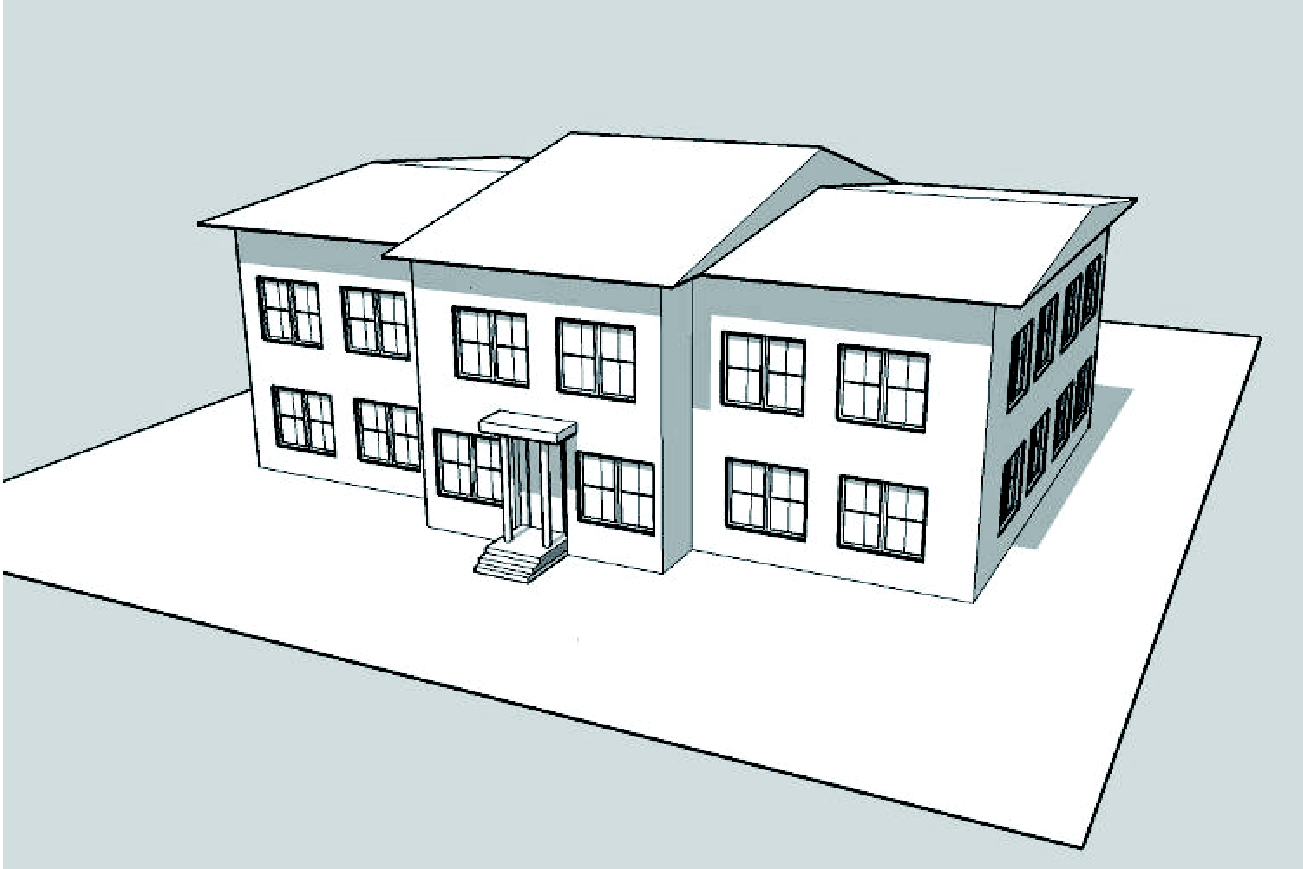
BGT Redevelopment Area Figure 10
Building Type: Apartment
(For illustrative purposes only)
b.
Yards : The apartment building typically has a primary yard located to the rear of the structure with secondary side yards and the potential for a small landscaped front yard . Corner lots shall have a front yard along each street frontage. Buildings located internal to a site may be arranged in a courtyard setting provided the site has at least 1 building oriented toward the street .
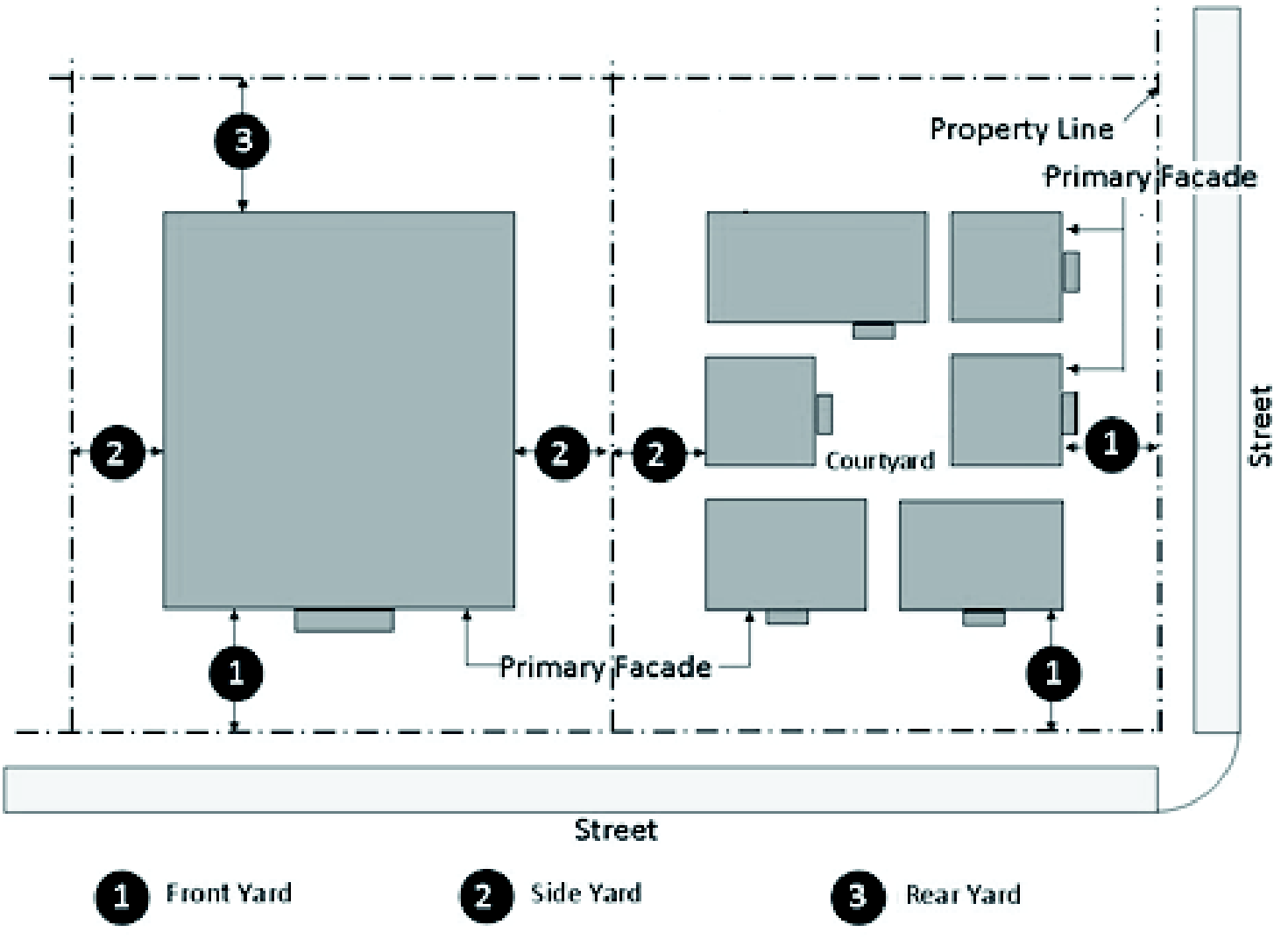
BGT Redevelopment Area Figure 11
Apartment Building Yard Diagram
(For illustrative purposes only)
c.
Elevation Details:
i.
All apartment building elevations visible from the street shall provide doors, porches, balconies, terraces and/or windows along a minimum of 60 percent of the front elevation and 30 percent of the side elevation for each building story . "Percent of elevation" is measured as the horizontal plane containing doors, porches, balconies, terraces and/or windows in relation to the total horizontal plane of the building elevation.
ii.
All apartment buildings are encouraged to provide design details and architectural features to provide visual interest, which may include the following:
a)
Dormers.
b)
Gables.
c)
Recessed entries.
d)
Covered porch entries.
e)
Pillars or posts.
f)
Eaves.
g)
Bay windows.
h)
Balconies.
i)
Decorative finish, such as wainscoating.
j)
Decorative cornices and rooflines (for flat roofs).
k)
Window trim (minimum 4 inches wide).
l)
Canopies, porticos, or porte-cocheres (integrated with the building's massing and scale).
d.
Massing and Scale: Apartment buildings shall relate in mass and scale to the adjacent built environment and shall avoid single, large, dominant building mass.
i.
Buildings over 10,000 square feet in gross building area shall include façade variations so that the maximum length, or uninterrupted curve, of any façade does not exceed 60 linear feet. Façade variations shall be provided through projections and recesses with a minimum depth of 5 feet and may include porches, balconies, bay windows and/or covered entries.
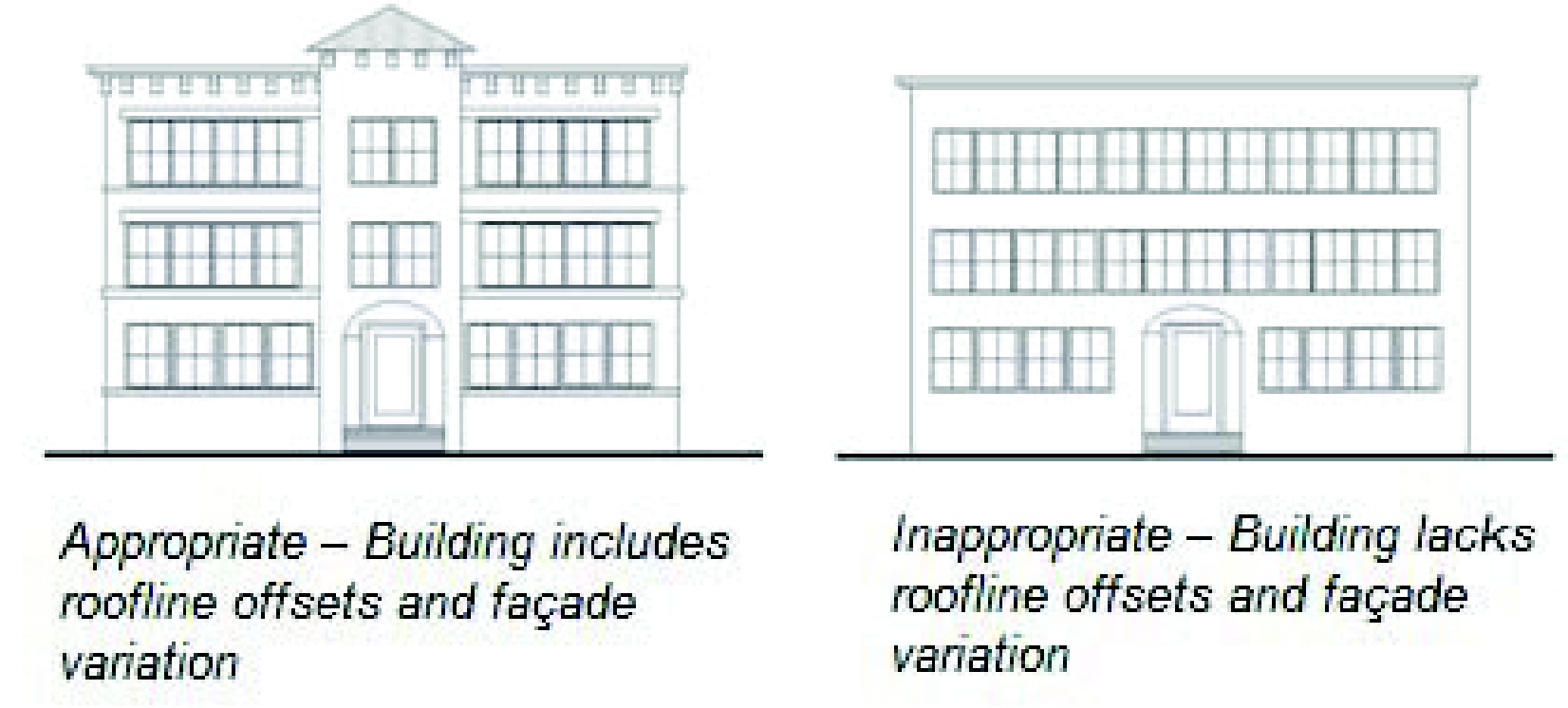
BGT Redevelopment Area Figure 12
Massing and Scale Diagram
(For illustrative purposes only)
7.
Building Type: MIXED-USE.
a.
Description: A building which can accommodate a variety of uses, typically with the ground floor dedicated to non-residential uses and upper story floor(s) dedicated to office and/or residential uses.
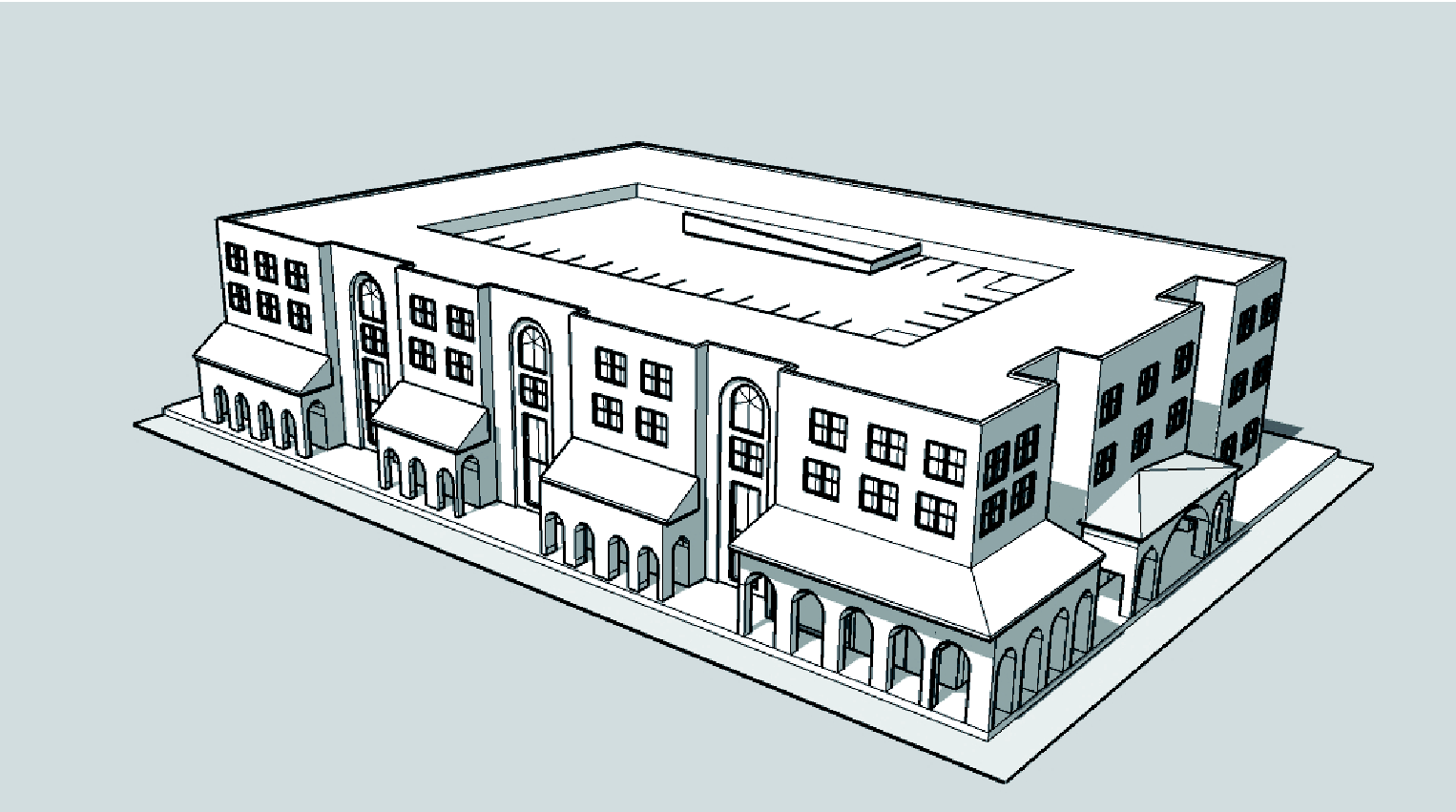
BGT Redevelopment Area Figure 13
Building Type: Mixed-Use
(For illustrative purposes only)
b.
Yards : The mixed-use building typically has a primary yard located to the rear of the structure with the potential for a small front plaza or courtyard to provide public space or outdoor dining.

BGT Redevelopment Area Figure 14
Mixed-Use Building Yard Diagram
(For illustrative purposes only)
c.
Multi- Story : Mixed-use buildings shall have a minimum of two stories . The first floor shall have a minimum floor-to-ceiling height of 14 feet.
d.
Street Façades : The first floor of all mixed-use buildings shall be designed to encourage and complement pedestrian-style interest and activity through the following elements:
i.
The first floor building elevation shall be located between the minimum and maximum front setback line (if provided) for a minimum of 60 percent of lot width.
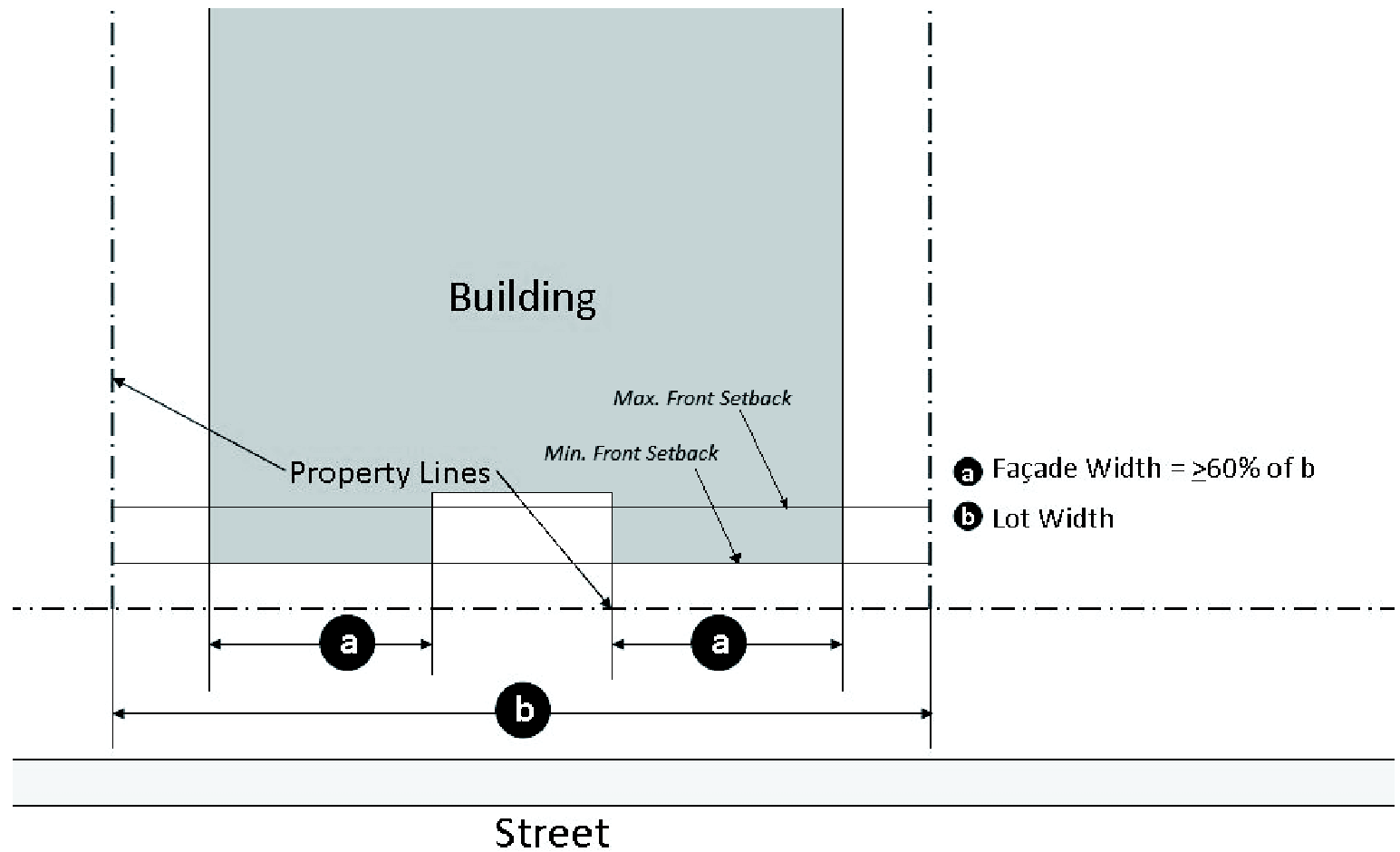
BGT Redevelopment Area Figure 15
Mixed-Use Building Facade Diagram
(For illustrative purposes only)
ii.
Glazing, consisting of transparent windows and doors, shall be provided along a minimum of 35 percent of the length of first floor building elevation along the primary street frontage . Building elevations along secondary street frontages shall provide 30 percent glazing.
iii.
Expanses of blank walls may not exceed 20 feet in length along the primary street frontage . A blank wall is a façade that does not contain transparent windows, doors, arcades, stairs or similar features.
e.
Windows: Windows along the first floor building elevation shall meet the following standards:
i.
Clear glass windows shall not exceed a tint of more than 25%.
ii.
Windows shall be located between 2 and 7 feet above sidewalk grade .
f.
Building Entrances: All mixed-use buildings shall have a clearly defined principal pedestrian entrance fronting the street . Additional entrances may be oriented toward the side and rear parking lots or pedestrian pathways .
g.
Elevation Details:
i.
All mixed-use buildings shall provide a minimum of 4 of the following design details and architectural features:
a)
Dormers.
b)
Gables.
c)
Recessed entries.
d)
Covered porch entries.
e)
Pillars or posts.
f)
Eaves.
g)
Bay windows.
h)
Balconies.
i)
Decorative finish, such as wainscoating.
j)
Decorative cornices and rooflines (for flat roofs).
k)
Window trim (minimum 4 inches wide).
l)
Canopies, porticos, or porte-cocheres (integrated with the building's massing and scale).
m)
Open arcade or covered walkway.
n)
Bulkheads.
o)
Transoms.
p)
Window hoods.
q)
Building awnings along first floor.
h.
Massing and Scale: Mixed-use buildings shall relate in mass and scale to the adjacent built environment and shall avoid single, large, dominant building mass.
i.
Mixed-use buildings shall include façade variations so that the maximum length, or uninterrupted curve, of any façade does not exceed 75 linear feet. Façade variations shall be provided through projections and recesses with a minimum depth of 4 feet.
ii.
Roofline offsets shall be provided to lend architectural interest and variety to the massing of a building and to relieve the effect of a single, long roof. The maximum length of an uninterrupted flat roof is 75 linear feet.
i.
Materials:
i.
Mixed-use buildings exteriors shall consist of wood clapboard, stucco finish, cement fiber board products, brick or stone.
ii.
Pitched roofs shall be metal seam (5v Crimp, standing seam or similar design), slate, copper, or wood shingles.
8.
Building Type: COMMERCIAL
a.
Description: A single or multi- story building which accommodates non-residential and automobile oriented uses, such as retail and office uses. This building type provides convenient vehicle access from the fronting roadway while minimizing the negative impacts of parking lots on an active pedestrian realm.
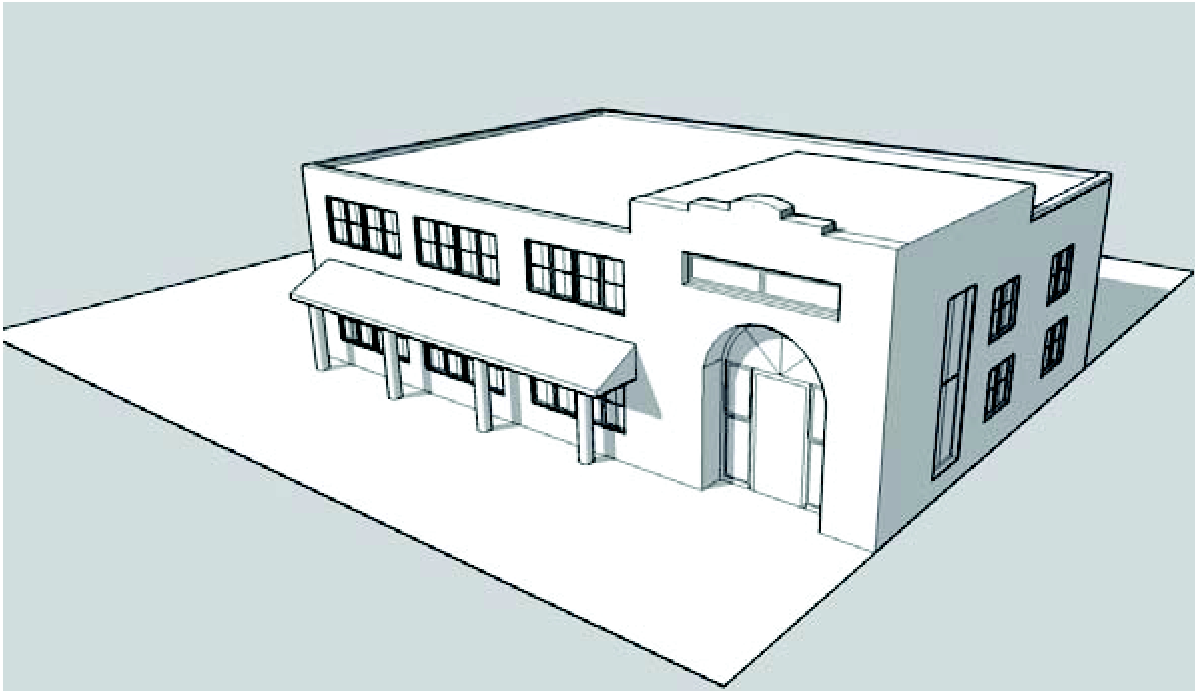
BGT Redevelopment Area Figure 16
Building Type: Commercial
(For illustrative purposes only)
b.
Yards : The commercial building has a primary yard located to the rear of the structure with the potential for a small front plaza or courtyard to provide public space or outdoor dining.
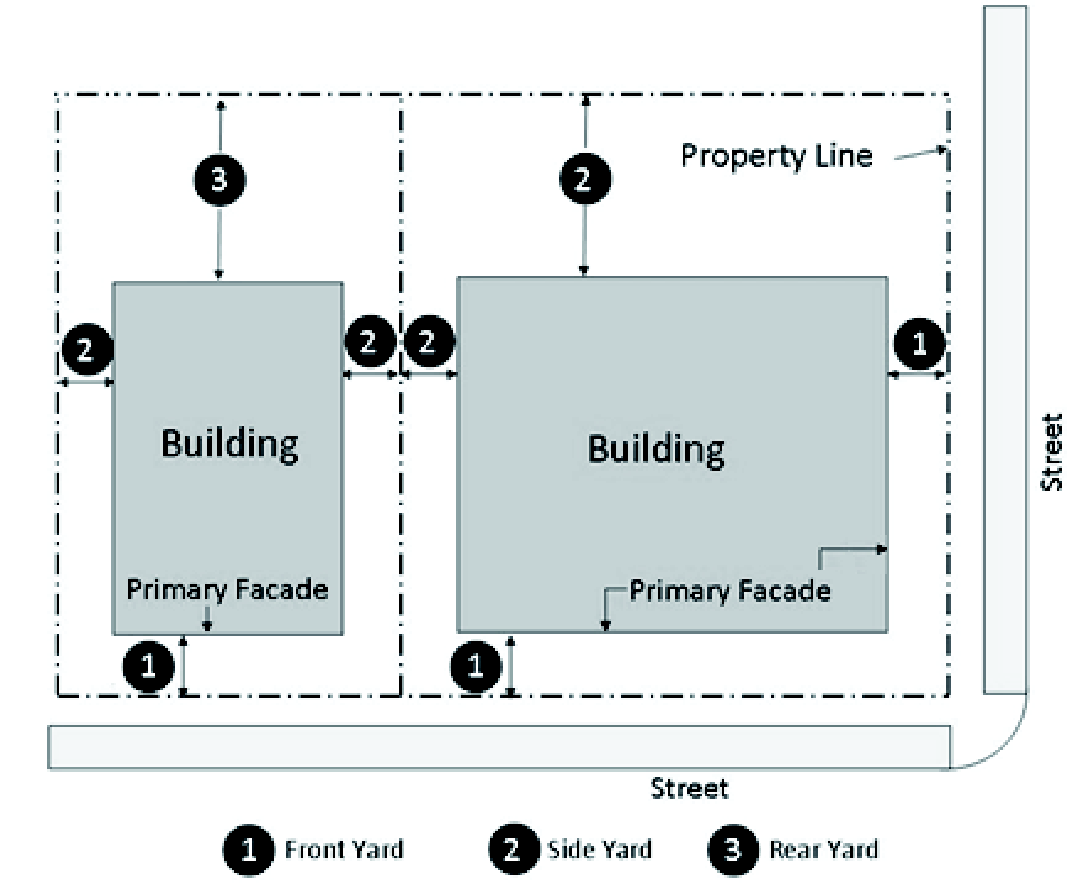
BGT Redevelopment Area Figure 17
Commercial Building Yard Diagram
(For illustrative purposes only)
c.
Street Façades : The first floor of all commercial buildings shall be designed to encourage and complement pedestrian-style interest and activity through the following elements:
i.
The first floor building elevation shall be located between the minimum and maximum front setback line (if provided) as provided in section 4.02.16 A.1.a.ii. for a minimum of 50 percent of lot width.
ii.
Glazing, consisting of transparent windows and doors, covering a minimum of 30 percent of the length of first floor building elevation along the primary street frontage . Building elevations along secondary street frontages shall provide 25 percent glazing.
iii.
Expanses of blank walls may not exceed 20 feet in length along the primary street frontage . A blank wall is a façade that does not contain transparent windows, doors, stairs or similar features.
d.
Windows: Windows along the first floor building elevation shall meet the following standards:
i.
Clear glass windows shall not exceed a tint of more than 25 percent.
ii.
Windows shall be located between 2 and 7 feet above sidewalk grade .
iii.
Buildings over 20,000 square feet in floor area may utilize spandrel glass, or other faux window treatment, for up to 25 percent of the glazing requirement.
e.
Building Entrances: All commercial buildings along Bayshore Drive shall have a clearly defined principal pedestrian entrance fronting Bayshore Drive. Additional entrances may be oriented toward the side and rear parking lots or pedestrian pathways .
f.
Elevation Details:
i.
All commercial buildings shall provide a minimum of 4 of the following design details and architectural features:
a)
Dormers.
b)
Gables.
c)
Recessed entries.
d)
Covered porch entries.
e)
Pillars or posts.
f)
Eaves.
g)
Bay windows.
h)
Balconies.
i)
Decorative finish, such as wainscoating.
j)
Decorative cornices and rooflines (for flat roofs).
k)
Window trim (minimum 4 inches wide).
l)
Canopies, porticos, or porte-cocheres (integrated with the building's massing and scale).
m)
Open arcade or covered walkway.
n)
Bulkheads.
o)
Transoms.
p)
Window hoods.
q)
Building awnings along first floor.
g.
Massing and Scale: Commercial buildings shall relate in mass and scale to the adjacent built environment and shall avoid single, large, dominant building mass.
i.
Commercial buildings shall include façade variations so that the maximum length, or uninterrupted curve, of any façade does not exceed 100 linear feet. Façade variations shall be provided through projections and recesses with a minimum depth of 4 feet.
ii.
Roofline offsets shall be provided to lend architectural interest and variety to the massing of a building and to relieve the effect of a single, long roof. The maximum length of an uninterrupted flat roof is 100 linear feet.
h.
Awning :
i.
For awnings spanning less than 25 percent of a façade , an applicant may request a deviation from the color restriction identified in section 5.05.08 D.11.c.iv. These deviation requests shall be subject to the procedures established in section 5.05.08 G. following the review and approval by the CRA Advisory Board to ensure consistency with CRA goals and objectives and community character.
9.
Building Type: CIVIC & INSTITUTIONAL.
a.
Description: A building that serves as a public gathering place and a focal point of the community. These buildings should be constructed as permanent long term additions to the area and include uses dedicated to religious, cultural, governmental or educational missions.
b.
General Requirements: Because of the unique characteristics of civic and institutional buildings , it is generally exempt from the standards imposed on other building types in this section and the architectural standards of section 5.05.08. The following standards shall apply:
i.
Buildings should be of sufficient design to serve as a visual anchor to the community.
ii.
All rooftop equipment shall be screened from view.
E.
Landscaping and Buffer Requirements
1.
Applicability: Landscaping and buffering in the BMUD and GTMUD shall be provided in accordance with section 4.06.00, unless as specified in this section.
2.
Buffer Requirements: Buffers shall be provided to give spatial separation and visual screening between incompatible uses.
a.
Perimeter Buffers : The following buffer standards shall be required for MUPs, PUDs, commercial developments and other non-residential developments in the BMUD-NC, BMUD-W and GTMUD-MXD subdistricts.
i.
Buffers adjacent to residential uses and residentially zoned properties shall be consistent with one of the following:
a)
Ten foot wide buffer including a 6 foot high opaque masonry wall and a row of trees spaced no more than 30 feet on center; or
b)
Fifteen foot wide buffer including trees spaced no more than 25 feet on center and a hedge consisting of ten gallon plants five feet in height, three feet in spread and spaced a maximum four feet on center at the time of planting.
ii.
Buffers adjacent to non-residential uses shall include a shared 10 foot wide buffer . Each property must contribute a minimum of 5 feet to the buffer . This buffer area may be provided in the form of landscaped area with plantings consistent with the Type A buffer requirements and/or hardscaped courtyards, mini-plazas, outdoor eating areas, and building foundation planting areas. This buffer requirement is not required in the side yard between non-residential uses that share a common wall or between shared parking facilities.
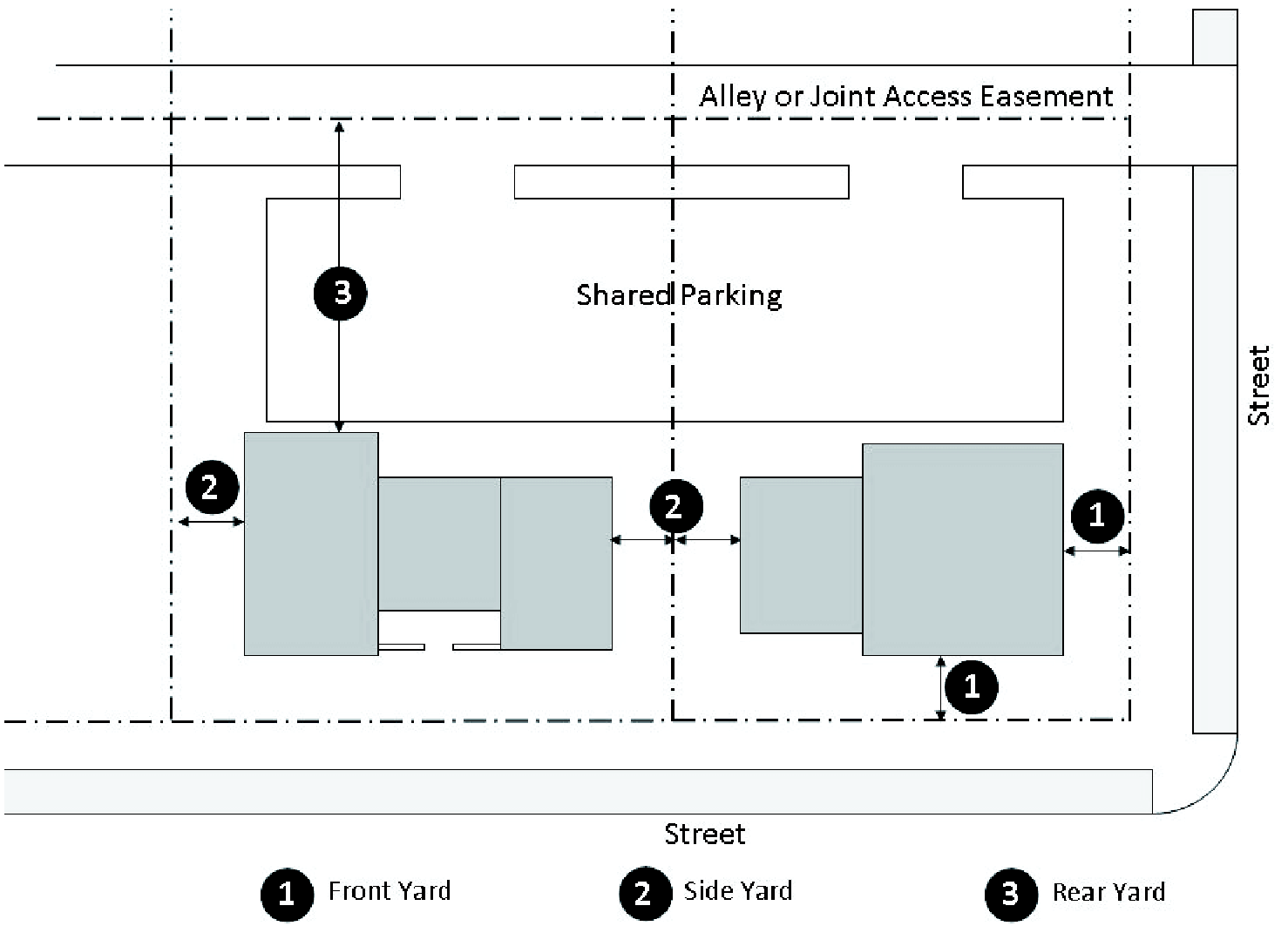
BGT Redevelopment Area Figure 18
Shared Buffer Diagram
(For illustrative purposes only)
iii.
Road Right-of-Way Buffers : Road right-of-way buffers for multi-family (excluding house and rowhouse building types) and non-residential developments are encouraged to coordinate with and complement the Bayshore Gateway Triangle Streetscape Guidelines.
a)
Developments within an Activity Center must provide a 20 foot Type D buffer adjacent to US 41, Tamiami Trail, meeting the design standards of section 4.06.02 C.4.
b)
All other developments shall provide a buffer consisting of one of the following:
1)
Minimum 10 foot wide Type D buffer meeting the design standards of section 4.06.02 C.4.
2)
A hardscaped area extending from the back of the street planting zone to the primary front façade . The hardscaped area shall perform as an expanded public realm and may include benches, outdoor eating areas, plazas, fountains, and art pieces.
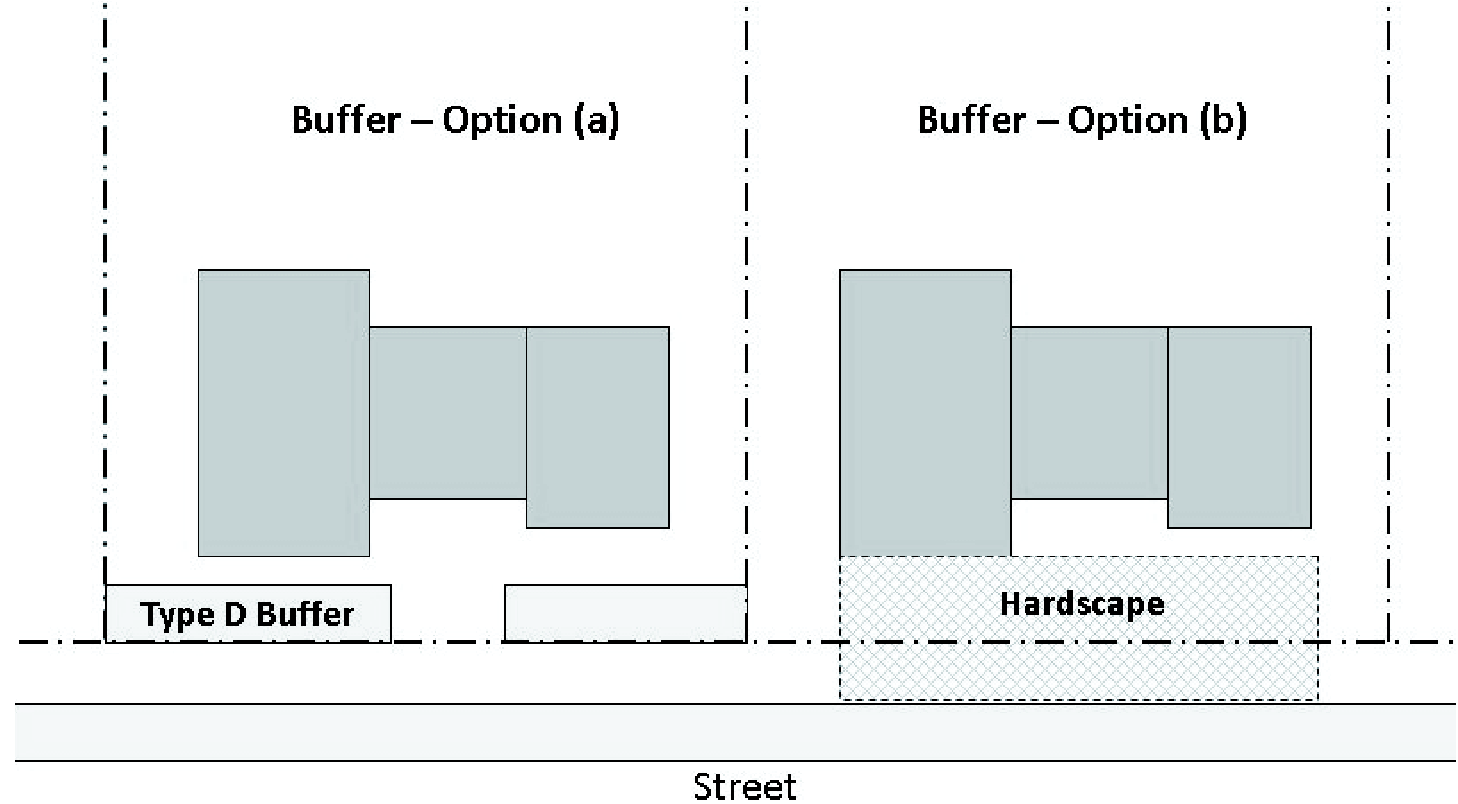
BGT Redevelopment Area Figure 19
Road Right-of-Way Buffer Diagram
(For illustrative purposes only)
3.
Parking Lot Landscaping:
a.
A maximum of 30 percent of the landscape islands may have a minimum width of 5 feet inside planting area and may be planted with a palm tree equivalent.
b.
Minimum tree size shall be 1-¾" caliper and a minimum of 10 feet in height.
c.
Parking lot perimeter:
i.
Parking lots shall include perimeter planting areas that are a minimum of 5 feet in width. Shrubs shall be arranged in a staggered pattern with a minimum size of 3 gallons at the time of planting to provide year-round screening. Trees shall be included in the perimeter landscape area at a minimum spacing of one tree/palm per 25 feet of linear frontage .
ii.
Streetwalls shall be used when surface parking lots for non-residential uses abut the right-of-way of Bayshore Drive, Van Buren Avenue, Thomasson Drive in the BMUD and US 41, Davis Boulevard, and Commercial Drive in the mini-triangle portion of the GTMUD.
a)
The wall shall complement the materials and colors of the primary buildings and be 3 to 4 feet in height and shall have a 12 inch projection or recess a minimum of every 15 feet.
b)
The streetwall shall be set back the same distance as the primary building façade ; however, the streetwall shall meet County standards for site distance triangles per section 4.06.01 D.1.
c)
The street side of the streetwall shall have trees at 30 feet on center planted within tree wells or a minimum 5 foot wide strip with ground covers other than grass.
d)
The streetwall structure shall be protected through the use of a root barrier system as identified by LDC section Figure 4.06.05.H.A.
e)
No streetwall is required if all of the parking is located in rear of the development .
4.
Building Foundation Planting: Building foundation plantings shall be required per section 4.06.05 of the LDC, except as follows. The building shall provide the equivalent of 10 percent of its gross ground level floor area , in building foundation planting area. A continuous building foundation planting width is not required per section 4.06.05 of the LDC. However, the foundation plantings shall be located within 25 feet of the building edge in the form of landscaped courtyards and seating area landscaping.
5.
Water Management Area: The water management area may be located within any required buffer area provided all buffer plantings can be accommodated.
6.
Plant Materials: Landscaping in the BMUD and GTMUD shall utilize tree and shrub plants that are identified in the Collier County Native Plant List in order to minimize maintenance and water demands after establishment. Ornamental plantings should be drought-tolerant in nature, consistent with Florida Yards & Neighborhoods Program, and cross-referenced with the latest Florida Exotic Pest Plant Council (FLEPPC) listing of invasive species (Categories I and II).
F.
Parking Standards. The purpose of the parking standards for the BMUD and GTMUD is to regulate the location, siting, and design of on- street and off- street parking in a manner that provides convenient access to adjoining uses, reduces increased surface level heat and glare, and enhances pedestrian, bicyclist and motorist safety and visibility within the built environment. Parking in the BMUD and GTMUD shall be as provided for in section 4.05.00, except as specified in this section.
1.
Parking Space Requirements: Parking spaces shall be provided in accordance with the following table. For uses not specifically listed, the most similar category shall be used to calculate the minimum parking requirements. Net Floor Area is defined as total floor area excluding mechanicals and core space.
Table 1. Parking Space Requirements in the BMUD and GTMUD
Use Type Minimum Parking Spaces Single-Family Residential 2.0/ dwelling unit Multi-family Residential 1-bedroom 1.0/ dwelling unit 2-bedroom 1.5/ dwelling unit 3 or more bedrooms 2.0/ dwelling unit Lodging 1.0/room Places of worship 1/4 seats (pews: 1 seat = 1.5 feet) Assembly/Museum/Gallery 1/500 sq. ft. of net floor area open to the public Institutional 1/300 sq. ft. of net floor area General Office 1/350 sq. ft. of net floor area Retail 1/300 sq. ft. of net floor area Restaurant 1/150 sq. ft. of net floor area or 1/4 seats, whichever is greater Industrial/Manufacturing 1/500 sq. ft. of net floor area Warehousing 1/1,000 sq. ft. of net floor area Note: Outdoor café seating shall be exempt from parking calculations.
2.
Adjustments to Parking Space Requirements: Developments which meet any of the following standards may be exempted from the minimum parking requirements of this section.
a.
Public parking facilities. The CRA can make parking on CRA owned property available to meet the minimum parking requirements for new construction or redevelopment projects. An applicant must provide documentation stating the parking allocation has been approved by the CRA as part of the MUP, site development or site improvement plan process. The public parking facility must be located within one-half mile of the development . Once spaces are allocated to a specific property through the approval of the MUP, SDP or SIP, the applicant has one year to begin utilizing the parking. If the spaces are not used within one year, and an extension is not granted by the CRA, the spaces will be made available for reallocation and all development orders shall be revised accordingly.
b.
Off-site parking. Off-site parking may be used in order to meet the minimum parking requirements, provided the off-site parking is located no farther than 1,200 feet from the use it will serve. The location and design of the off-site parking will be shown on the SDP or SIP and approved as part of the SDP or SIP review and approval process. The required parking spaces will be committed by a recordable covenant, lease, or other agreement.
c.
Shared parking. Shared parking is permitted for new development if the applicant establishes that the peak parking demands for the new uses clearly occur at different times. A shared parking agreement must be recorded by a recordable covenant, lease, or other agreement. Shared parking lots must be within 600 feet of each use and may not be separated from the use by a street right-of-way or easement exceeding 60 feet in width.
d.
On- street parking. Where on- street parking exists or is permitted, a development may count the spaces directly along the site's frontage toward the minimum parking requirement, however the on- street parking spaces are considered public spaces and are not for the exclusive use of the adjacent use.
e.
Tree preservation. The minimum number of spaces required may be adjusted by the County Manager or designee when it has been determined that the reduction is necessary to preserve a healthy tree or trees (with a 12 inch or greater diameter at breast height) from being damaged or removed, and where the site plan provides for the retention of said tree or trees.
f.
Connectivity. Parking lots are encouraged to connect to adjacent lots through the use of a joint access easement . If a joint access easement is provided for connectivity, then the minimum parking requirement for the use may be reduced by 10 percent.
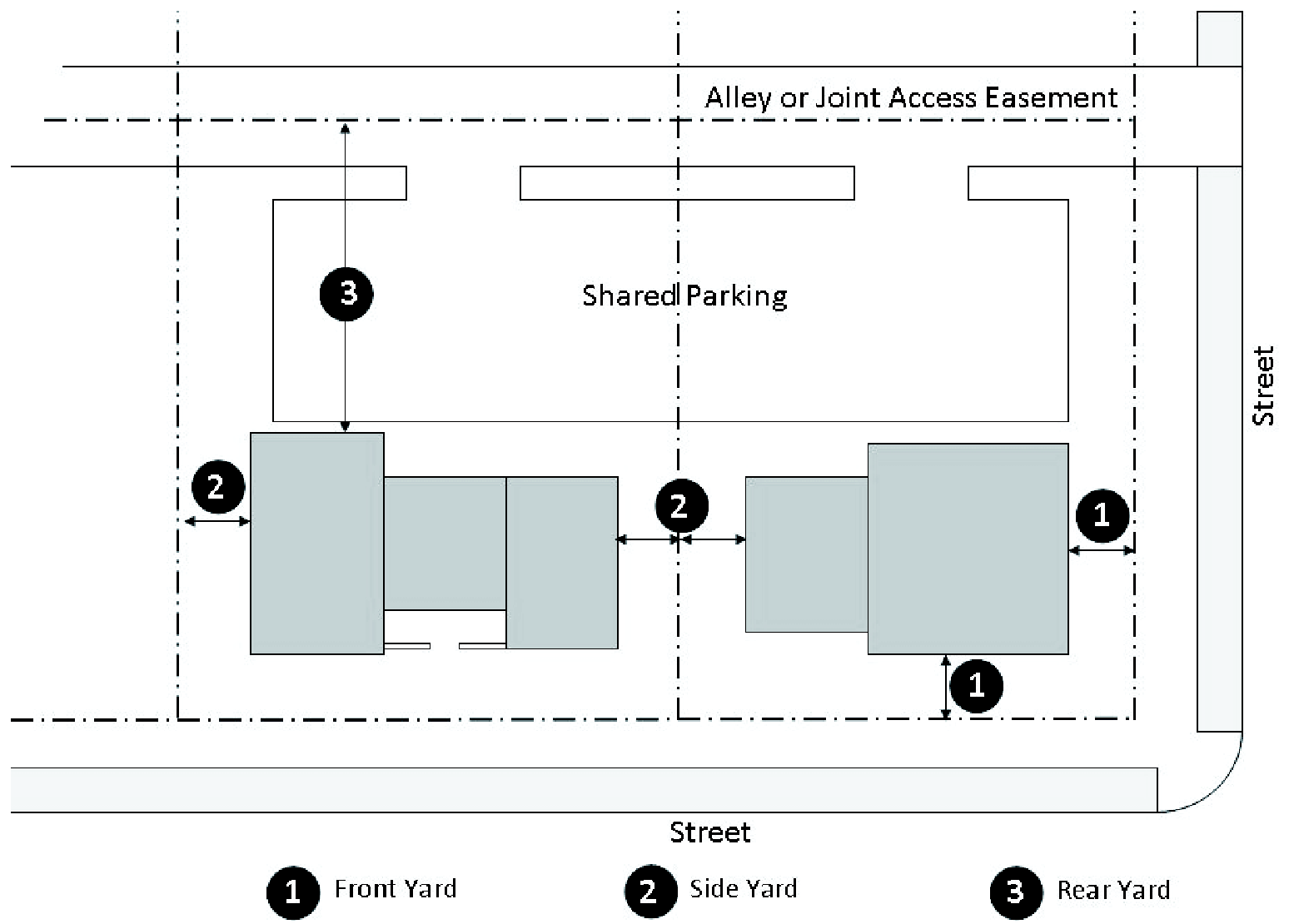
BMUD and GTMUD Area Figure 20
Parking Diagram
(For illustrative purposes only)
3.
On- Street Parking.
a.
On- street parking may be allowed on local streets subject to an approved right-of-way permit to construct parking spaces in the public right-of-way .
b.
Parallel parking shall be a minimum of 9 feet wide by 23 feet long, but is not required to be striped. For every 5 on- street parking spaces provided, a landscape island that is 8 feet wide and 15 feet long and is surrounded by Type D concrete curbing shall be provided, in addition to the pedestrian clear zone landscape requirement. The corners adjacent to the travel lane shall be angled at least 45 degrees away from perpendicular with the curb in order to provide adequate ingress and egress from each parallel parking space. Each island shall be planted with hedges, groundcover and/or grasses less than 36 inches high and shall contain at least one small to medium ornamental tree that is a minimum of 8 feet tall at the time of planting.
c.
Angled parking may be 45 degrees or 60 degrees from the travel lane. Spaces must be a minimum of 9 feet wide and 18 feet long. For every 8 on- street parking spaces provided, a landscape island that is 12 feet wide and 15 feet long and is surrounded by Type D concrete curbing shall be provided, in addition to the pedestrian clear zone landscape requirement. The island shall be planted with hedges, groundcover, and/or grasses less than 36 inches high and shall contain at least one small to medium ornamental tree that is a minimum of 8 feet tall at the time of planting.
4.
Off- Street Parking Location: Off- street parking is encouraged to be located to the side or rear of the building in order to establish a pedestrian friendly environment. Off- street parking in front of buildings abutting Bayshore Drive and Thomasson Drive in the BMUD and US 41, Davis Boulevard and Commercial Drive in the mini-triangle area of the GTMUD shall not exceed 50 percent of that building's parking requirements and shall be limited to a single-aisle double loaded parking lot.
5.
Bicycle Parking: Bicycle parking shall be required as provided for in section 4.05.08, except as provided below.
a.
Number of Required Spaces: The number of bicycle parking spaces shall be as provided for in section 4.05.08 B.
b.
Location: Bicycle parking shall have access via sidewalks , pathways or driveways to the public right-of-way and be located as provided below:
i.
Parking Structures : Required bicycle parking within a structure shall be located in or near main entrances or elevators to provide for pedestrian safety, visibility, and security of property.
ii.
On Site: Bicycle parking (not located within a parking structure ) shall be located on site within 50 feet of main building entrances. Bicycle parking shall not obstruct walkways.
iii.
Right-of-Way : Bicycle parking may be located in the public right-of-way subject to an approved right-of-way permit.
iv.
Shared Bicycle Parking: Where there is more than one building on a site, or parking is shared with an adjacent site, bicycle parking shall be distributed equally to serve all buildings and main entrances.
G.
Signage. Signage shall be permitted as allowed by section 5.06.00, except as otherwise regulated by this section for specific uses.
H.
Murals. Murals are allowed as public art within the Bayshore Gateway Triangle Redevelopment Area subject to the following conditions:
1.
Murals are only allowed on commercial, civic or institutional buildings .
2.
Building must be located within the proposed Cultural District boundary, Community Redevelopment Agency Resolution 08-60, and cannot be located along U.S. 41.
3.
One mural is allowed per building .
4.
Murals are permitted on sections of buildings where there are no windows or doors or where the mural will not interfere with the building's architectural details.
5.
The mural cannot exceed 200 square feet unless specifically approved by the CRA Advisory Board.
6.
The mural shall not contain text for the purpose of advertising any business or commercial activity.
7.
The mural cannot be temporary in nature and the building owner must commit to maintaining the mural.
8.
Review and approval from the CRA Advisory Board is required to ensure the mural complies with the conditions above and that the artwork complements the design of the building in color, shape, and location.
(Ord. No. 06-08, § 3.J; Ord. No. 06-63, § 3.Q; Ord. No. 07-68, § 3.C; Ord. No. 12-39, § 3.C; Ord. No. 14-33, § 3.K; Ord. No. 16-22, § 3.C)